Call it weed, call it pot, call it dope, ganja, bhang, hash, or Mary Jane, but you’d be hard-pressed to find a plant that’s had a greater impact on the world than this green giant. Used throughout history for healing, recreational, and spiritual purposes, cannabis is now a massive global industry.
In high doses, cannabis may have psychedelic effects, although debate rages as to whether cannabis may be classified as a psychedelic substance. In addition to its recreational, entheogenic, therapeutic, or other uses, cannabis also has a multitude of medical purposes, and has been the focal point of numerous studies and clinical trials for its treatment of conditions like chronic pain, anxiety, fibromyalgia, and more. As with any substance, there are potential drawbacks to cannabis use as well, including the potential for paranoia, cannabis use disorder, and more. (1, 2, 3, 4)
While cannabis has a longstanding history of therapeutic and ritual use, such as among devout Hindu sects in India, it was made illegal in President Nixon’s War on Drugs and only since the 1990s has it begun to see policy reform restoring its legal status in various jurisdictions. To this day, cannabis remains one of the world’s most impactful plants.
What is Cannabis?
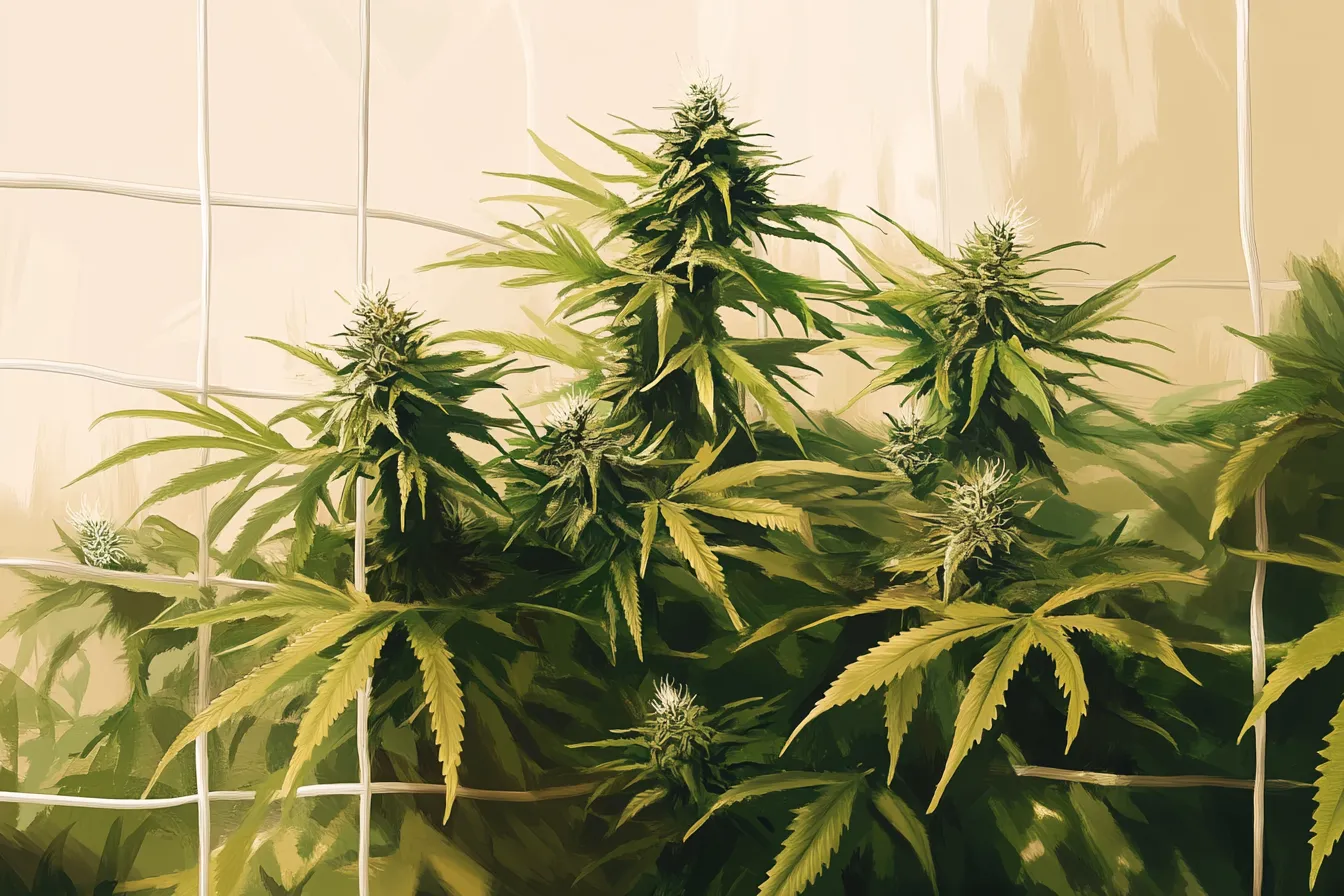
Cannabis is a plant that comes in multiple varieties and whose dried flower (bud) is used for its psychoactive and medicinal effects. The type of cannabis that people consume usually refers to the dried flowers of the plant. It contains chemicals called cannabinoids which have various psychoactive and physiological effects and act on the body’s endocannabinoid system (endogenous receptors, ligands, and enzymes throughout the body that have the unique capacity to interact with cannabinoids). One of the cannabis plant’s main intoxicating components is the well-known cannabinoid known as Delta-9-tetrahydrocannabinol (THC), while its best known non-intoxicating cannabinoid is cannabidiol (CBD). Both have different, but noticeable, effects. The flavors and taste profiles of the cannabis plants mainly come from chemical compounds called terpenes (5).
Keep Up with Uncensored Psychedelic Trends
Join our newsletter at Psychedelics Uncensored.
We respect and protect your privacy. By subscribing your info will be subject to our privacy policy . Unsubscribe easily at any time
There are several varieties of cannabis, including the non-intoxicating hemp plant which can be a source of protein in its seeds, or used for textiles, building materials, or even sustainable energy. (6, 7, 8)
Cannabis Indica vs. Sativa vs. Hybrid
There are two main types of cannabis subspecies – indica and sativa.
Indica
Cannabis indica plants are primarily known for their relaxing effects, significant body load, and sleep-inducing benefits. Indica plants are native to Afghanistan, India, Pakistan, and Turkey, are usually bushier and shorter than cannabis sativa plants, and grow faster. Typically, they have higher levels of CBD (which we’ll cover later in this guide) than THC (the main intoxicating chemical in cannabis), which may lead to their relaxing effects. Indica strains may also reduce nausea and act as a pain reliever. (6, 7)
Sativa
Cannabis sativa plants are native to Africa, Central Asia, and Southeast Asia. In contrast to cannabis indica plants, sativa plants are usually tall and thin, with slender leaves. Cannabis sativa is usually associated with mental stimulation, and energizing, anxiety-reducing effects, some users prefer to consume in the daytime. It also usually has a higher THC-to-CBD ratio. (8)
Keep Up with Psychedelic Trends
Get uncensored psychedelic news, events, and updates. Join Psychedelics Uncensored!
We respect and protect your privacy. By subscribing your info will be subject to our privacy policy . Unsubscribe easily at any time
Hybrid
Hybrid plants are crossbred between sativa and indica. Most cannabis plants are on a spectrum of hybrids. Crossbreeding happens by crossing one strain with another strain by selectively breeding male and female plants of various strains. The breeding process involves a male plant pollinating a female plant, which produces seeds with both plant genes, and, therefore, a new, hybrid strain. In cannabis, only female plants can produce enough THC to have any effects. (9, 10)
What Are Terpenes?
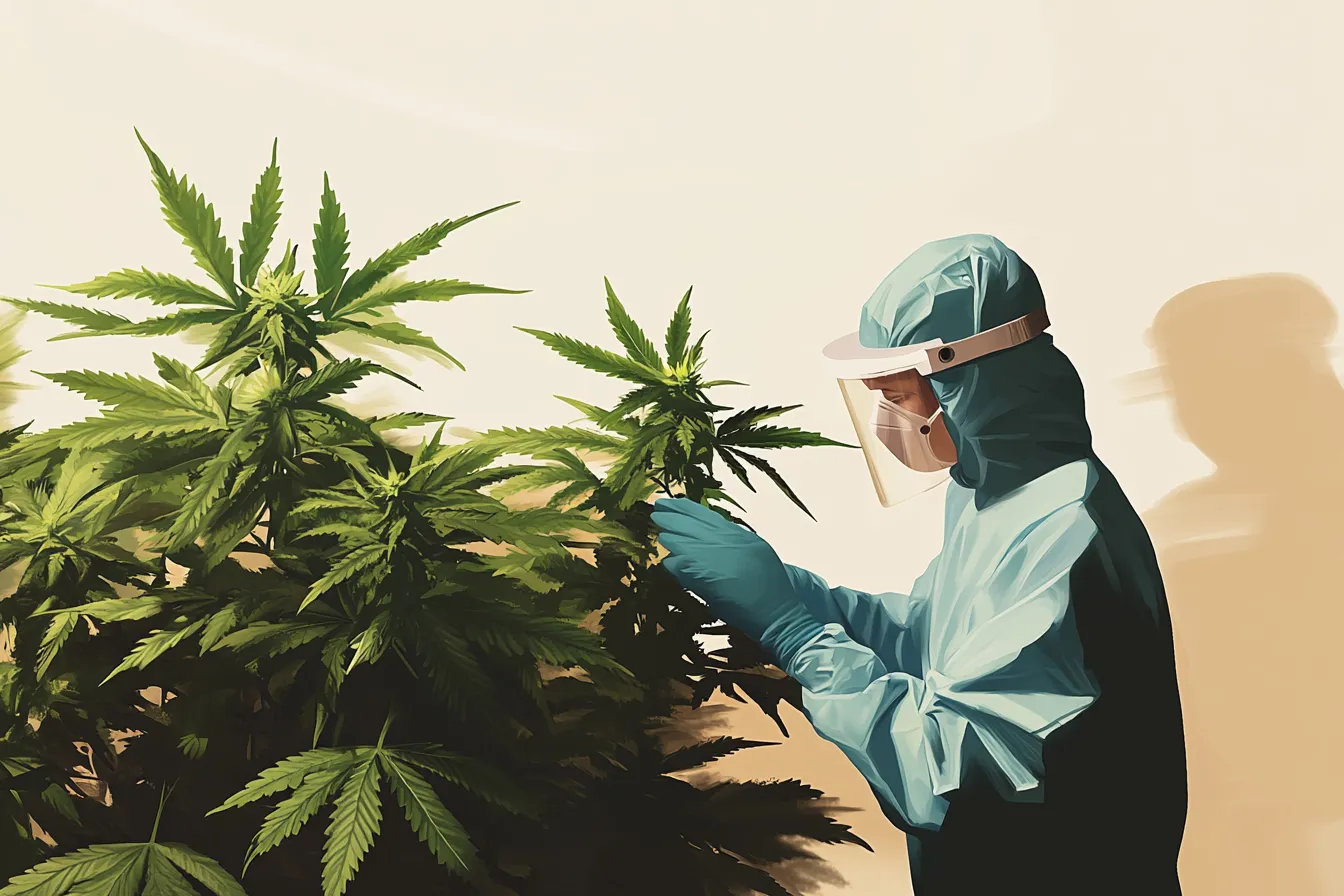
Modern research has suggested that the difference between sativa and indica is not as important as terpenes when it comes to cannabis effects and consumption. Terpenes are, in essence, responsible for the flavor profiles of cannabis, as well as other sensory qualities, which affect the consumer experience. There are more than 200 identified terpenes in cannabis, all of which have major effects on how the plant affects humans’ bodies and brains. Indeed, according to what’s known as the “entourage effect,” there is a synergistic relationship between all the cannabinoids, terpenes, and other molecules in the cannabis plant, impacting the way they all interact and affect the consumer. (11)
What is THC?
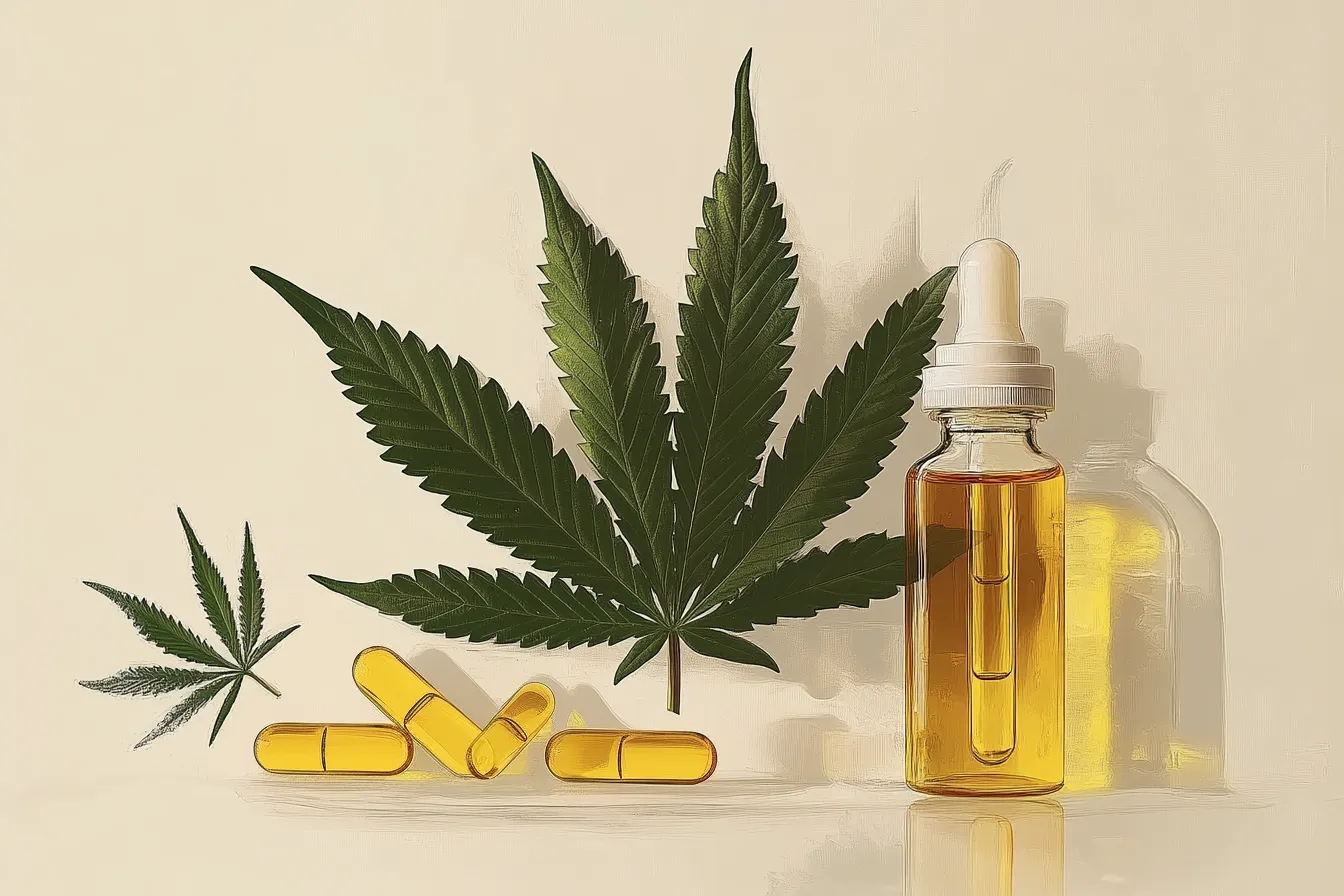
Tetrahydrocannabinol is a cannabinoid found in the cannabis plant. It’s one of 113 other cannabinoids in the plant, and is the one responsible for the bulk of cannabis’ psychoactive effects. THC exists in the plant as an acidic precursor, known as Tetrahydrocannabinol acid, or THCA. When heated, THCA turns into THC. THCA on its own is not psychoactive; that’s why eating raw cannabis plants won’t have any psychoactive effect. THC can have several effects, both positive and negative, including creating a happier, more relaxed sensation, slower reactions, increased appetite, sleepiness, impaired memory, altered senses, paranoia, and more. (12, 13)
What is CBD?
CBD is another cannabinoid found in cannabis. It is non-intoxicating. It is sometimes offered as a prescription medicine for treating 3 rare forms of pediatric epilepsy. It is the second most pervasive compound in cannabis and is derived directly from the plant. It can cause fatigue, dry mouth, relax muscles, ease anxiety, and more. Currently, CBD is widely consumed in the form of oil and gummy candy. (14)
What is CBG?
Cannabigerol, or CBG, is a type of cannabinoid that is derived from all cannabis plants, though young plants have higher levels. CBG may help with chronic pain, anxiety, and sleep issues. Unlike CBD, which can be more of an appetite suppressant, CBG may act as more of an appetite stimulant. It is also more full of fatty acids and antioxidants than CBD. There have not been as many studies on CBG as other cannabinoids, and so no claims can be confirmed yet without further research. (15)
What is CBN?
CBN is cannabinol, another cannabinoid found in cannabis plants. However, unlike THC, CBD, and CBG, CBN is not typically found in fresh plants; instead, CBN is more often found in cannabis plants as they age and break down. While CBD is completely non-intoxicating, CBN, when taken in large doses, can have some intoxicating effects. It is typically seen as a weaker version of THC, with about 25% of its effectiveness. CBN has some sedative properties and could help with anxiety and sleep disorders. It can be found in products marketed for sleep, though more research is needed to make substantiated claims about CBN’s efficacy and uses. (16)
Cannabis History & Culture
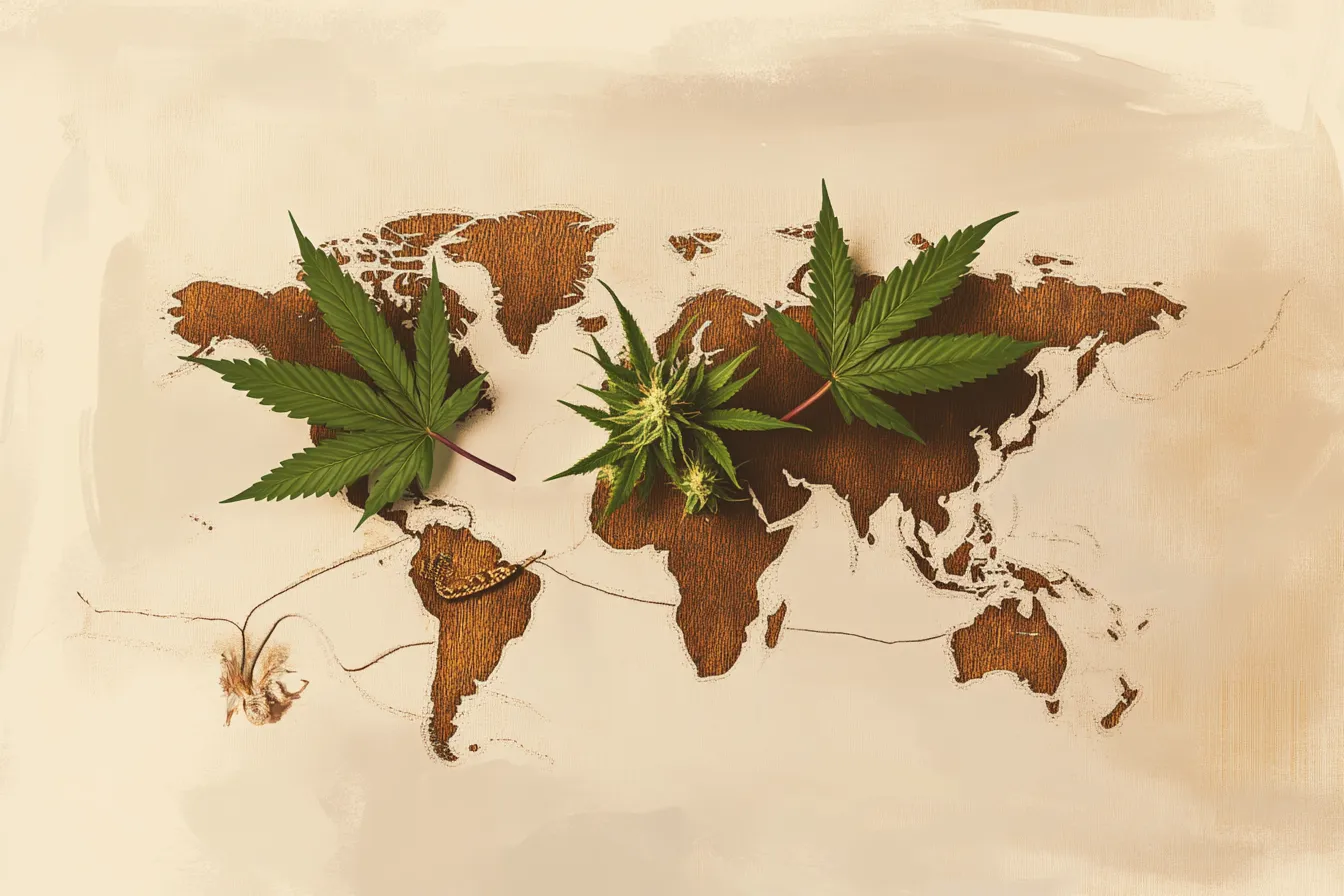
Ancient History (5000 BCE – 500 CE)
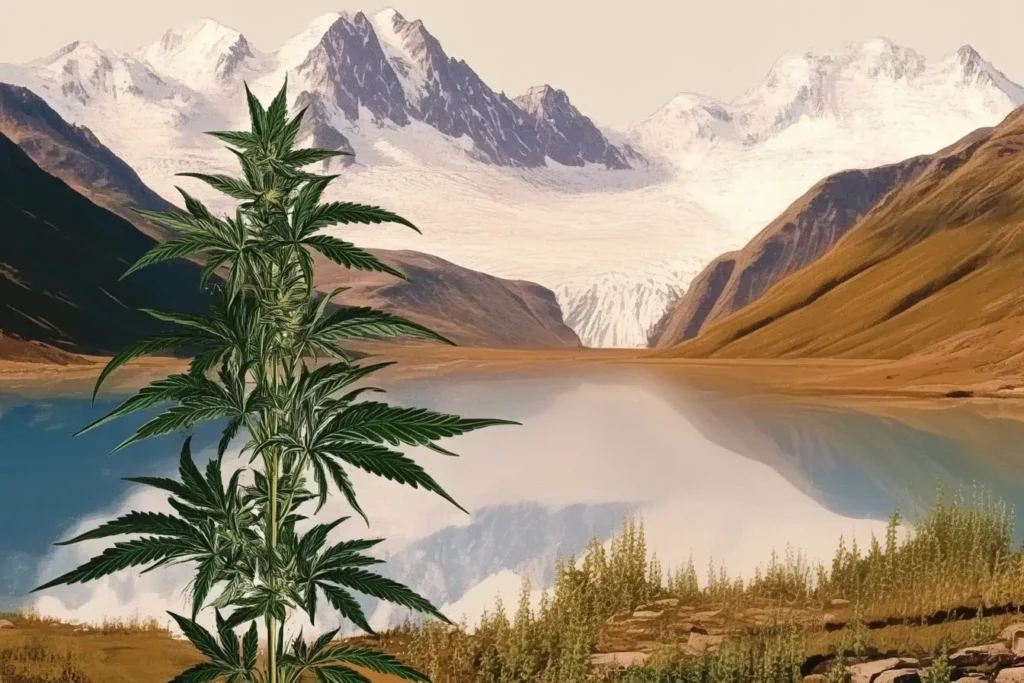
Cannabis use can be traced through human history as early as nearly 12,000 years ago, near the Altai Mountains in Central Asia. After this, it spread from Asia into the Middle East and Africa, before eventually reaching Europe and the modern Western world. (17)
The first documented use of cannabis is from 2800 BCE, in western China, where it was listed in Emperor Shen Nung’s Divine Husbandman’s Materia Medica, among a list of over 365 medicines. (18, 19)
Archeological findings and research show us that back then, cannabis plants were mostly used for fiber and for their seeds. Hemp is one of the world’s strongest natural fibers and was cultivated to make textiles and other durable materials and tools. As for the seeds, they were seen as a valuable source of nutrition. Cannabis seeds were likely grown and consumed raw, as they were full of fatty acids, ground into flour, or mixed into food. (20)
Other cultures found and utilized cannabis, as well. Ancient texts from the Hindus, Assyrians, Greeks, and Romans contain notes on cannabis and its medicinal and therapeutic uses and potential treatments for various physical and mental ailments, including arthritis and depression (or “melancholia”), lack of appetite and even asthma. (21)
In India, cannabis, often called “bhang,” has been used since at least 2000 BCE. (22)
The Hindu deity Shiva is frequently associated with cannabis, even given the title “Lord of the Bhang” due to his love for the plant. In the ancient Hindu sacred texts, the Vedas, composed from 1500-500 BCE, bhang is listed as one of five sacred plants in the fourth Veda, the Atharvaveda. (23, 24)
From 3000-1000 BCE, cannabis spread to the Middle East. It’s believed that Indica strains originated in places like modern-day Afghanistan. Aryan cultures helped bring cannabis to the Assyrians, Egyptians, and Hebrews, who burned it as incense and used cannabis in holy anointing oil. (25, 26)
The Ancient Greeks were also familiar with cannabis, especially as a medicine. It was often used to dress wounds on their horses. As for human consumption, they would steep the seeds in water or wine, later using the extract to treat inflammation. (27)
Cannabis pollen (alongside nicotine and coca plant) has been found in the tomb of popular Egyptian king Ramses II, who passed away in 1213 BCE. Egyptians may have discovered the uses and benefits of cannabis nearly 5,000 years ago, with evidence, such as hieroglyphs of cannabis leaves above the head of Seshat, an ancient Egyptian goddess, implying a connection to mind expansion and consciousness, and the Ebers Papyrus, an ancient medicinal text that contained several uses and acknowledgements of medical cannabis, including recipes to treat vaginal bleeding, glaucoma, ad cataracts, among other things. (28, 29)
Post-classical period (500 CE – 1500 CE)
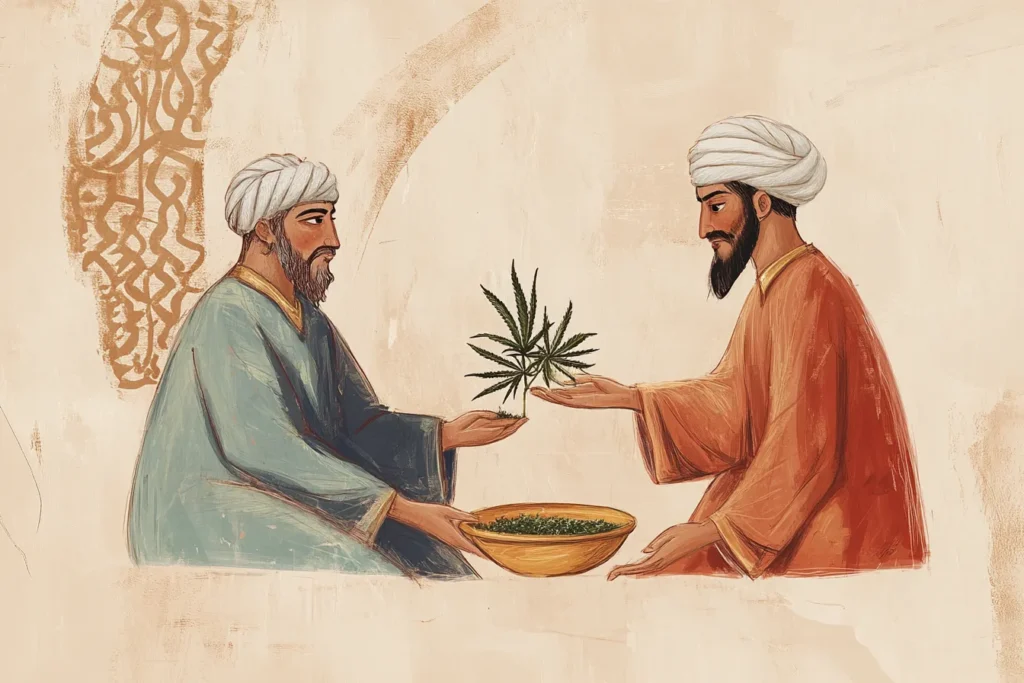
Hashish, also known simply as “hash,” is produced from the resin of cannabis plants, then compressed into a solid form. It’s consumed by smoking or eating, though smoking is the preferred method. Hashish consumption was discovered to be particularly popular in the Middle East during the Islamic Golden Age, which took place between the 8th and 13th centuries. (30)
During the time of the prophet Mohammed (around 500-632 CE), cannabis consumption and hashish were unknown. It is believed that this is why the Quran does not explicitly prohibit cannabis the way it decries intoxication from fermented beverages such as beer. (30)
In the 9th century, Arab scholars became aware of the medical benefits of cannabis after translating the Greek texts of Dioscorides and Galen. This was further explored by travelers coming through the Middle East by way of India and Asia, where the populace already had long standing familiarity with cannabis. The late 9th century is when hashish use “as an intoxicant surfaced in Islam,” (Nahas 814-815). Originally, it was consumed by religious Persian and Iraqi sects, before becoming popular with Islamic mystic Sufis, who developed a special way of consuming and preparing hashish, and generally becoming well-known to the entire Arab world by the 11th century. (30)
Avicenna, or Ibn Sina, was a Persian physician widely regarded as the most influential medical writer of the Middle Ages. He authored the Canon of Medicine in 1025 CE. Avicenna was greatly influenced by Chinese, Indian, and Persian medicine. His book provided a long list of drugs and their uses. Among them was cannabis, which was recommended for things like infectious wounds, gout, and uterine pain. The Canon of Medicine was translated to Latin in the 12th century and became one of the most influential books of its time, setting the standard for European medicine during the Middle Ages. (31)
Modern history (1500 CE – Present)
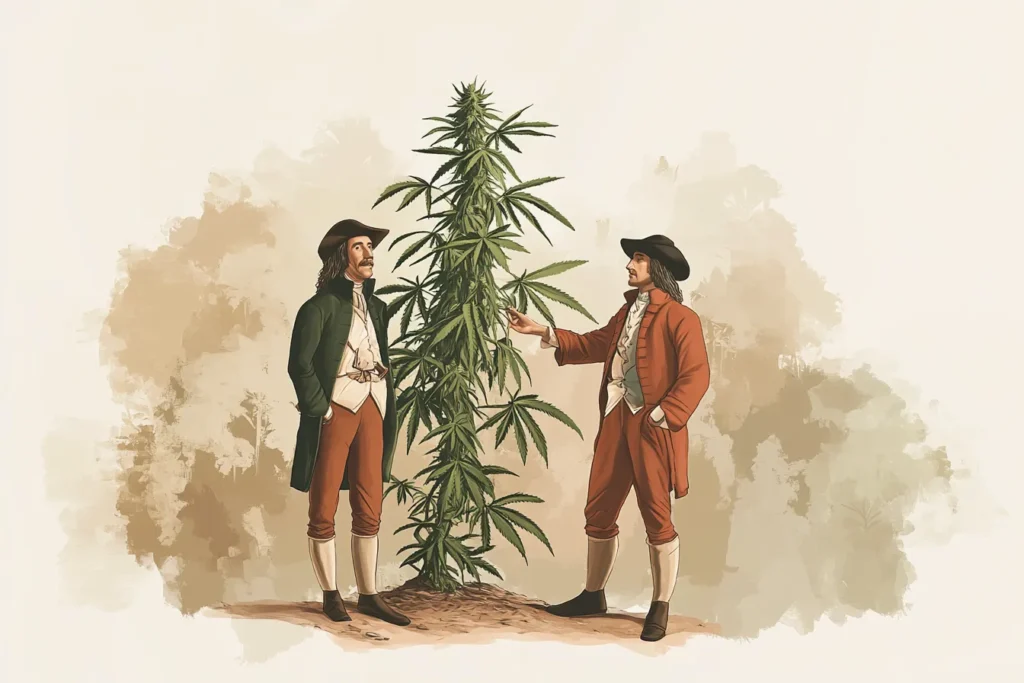
In the 16th century, King Henry VIII of England strongly advocated for hemp cultivation. As a result, industrial hemp became valuable and popular in Europe. (32)
Napoleon Bonaparte’s 1798 invasion of Egypt led to their discovery of hashish in a failed attempt to find alcohol. It quickly became a favored substance. There was some cultural interest in cannabis as a mind altering substance and a medicine in Europe at the time thanks to information brought back from various doctors, physicians, and explorers. Paris even had a group dedicated to varied drug experiences, including hashish. The Club des Hashischins, active from 1844 to 1849, had some notable members, including Charles Baudelaire, Victor Hugo, and Alexandre Dumas. At this time, recreational substance use was common among upper classes and intellectual society. (33, 34)
The 19th century brought even further interest in cannabis, after Irish physician Willian O’Shaughnessy, who first came across it as “Indian hemp” in Calcutta, brought some back with him to England in 1842. (35)
According an article titled the History of Cannabis and the Endocannabinoid System, cannabis then became viewed as the “persona grata in Western medicine,” with even Queen Victoria taking it for painful period cramps. (35)
Cannabis became more well-known in the United States after the Mexican Revolution of 1910 when immigration from Mexico increased, and some of the new residents brought cannabis culture with them. (36)
In the 1920s, during the (alcohol) Prohibition Era, cannabis was sold in cafes and jazz clubs known as “teapads” and was generally looked down upon (although it was not federally illegal until 1937). (37)
Bans on cannabis started even in the 1300s, and continued through parts of Europe, Africa, and the Islamic World to the 19th century, and started in the U.S. in the 20th century. The Marihuana Tax Act in 1937 started regulating the import, cultivation, distribution, and possession of cannabis, and cannabis was later removed from the medical pharmacies of America. 1961 saw the United Nations place cannabis in the same category as heroin, and the 1970s saw cannabis listed as Schedule I, the strictest control regime, by the USA. (38, 39)
Today, cannabis is the subject of research once more. The discovery of the endocannabinoid system in 1988 has led to reopening the conversation around cannabis and its potential uses. Cannabis is now widely seen as a therapeutic medicine for patients with cancer, as THC is known to increase appetite and offer relief from nausea caused by chemotherapy. Nine countries, including Canada and Mexico, have legalized recreational cannabis, with the total number of countries legalizing cannabis in some form standing at over 40. (40)
As of 2022, the global cannabis industry is worth over $43 billion USD and is expected to grow to $444 billion by 2030. (41)
New research on cannabis use as a medical and therapeutic tool has increased exponentially and there are hundreds of cannabis conferences, events, and meetings happening around the world. The future of cannabis research looks prolific and well-funded.
Is Cannabis a Psychedelic?
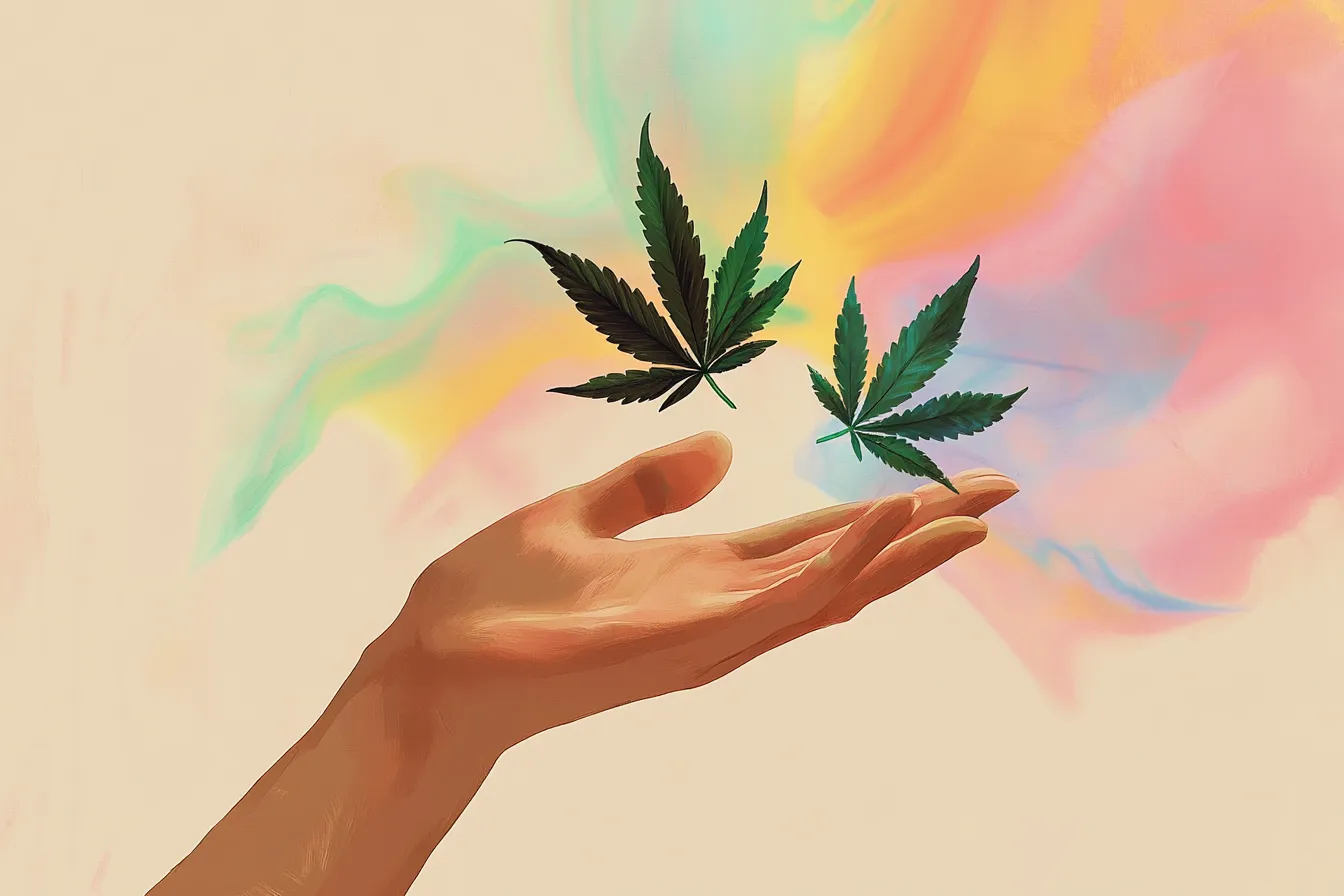
The word psychedelic comes from Humphry Osmond, who derived the term etymologically from the Greek root words “psyche” and “delic,” meaning mind-manifesting. (42)
However, this terminology is from the 1950s, and consumers of various substances (as well as breathwork practitioners) might argue that many substances and experiences are mind-manifesting. The seminal publication Psychedelic Drugs Reconsidered defines [psychedelics] as a drug that “more or less reliably produces thought, mood, and perceptual changes otherwise rarely experienced except in dreams, contemplative and religious exaltation, flashes of vivid involuntary memory and acute psychosis.” (43)
So is cannabis psychedelic?
If one judges by the attributes associated with traditional psychedelics, like LSD or psilocybin, cannabis doesn’t exactly qualify. These classical psychedelics are classified as tryptamines, which activate the brain’s 5-HT2A receptors, which cannabis does not. It primarily interacts with the body through the endocannabinoid system. (44, 45)
That said, many argue that cannabis does produce psychedelic, or psychedelic-like, effects. A recent study published in the Journal of Psychopharmacology suggests that THC does have psychedelic effects, particularly in high doses, “but that these effects may not have been observed in recent controlled research studies due to the doses, set, and settings commonly used.” (46)
Famed speaker, writer, and philosopher Alan Watts included cannabis in his personal list of psychedelics. (47)
One can view cannabis as something adjacent to a psychedelic, contingent on its THC potency and effects, as well as the way it is used, noting that its use is very different from that of classical psychedelics. Alternatively, cannabis can be perceived as something to use alongside psychedelics, not necessarily as a standalone one. (48)
The Intersection of Psychedelic and Cannabis Culture
While cannabis might not be an exact fit in the “psychedelics” category, using cannabis with psychedelics is a long-favored technique by cannabis lovers and psychonauts alike.
Both cannabis and psychedelic culture share a common thread in music, art, and counterculture. While both levels of substances have been used in ancient cultures for various ritual purposes, a bridge can be drawn between the two of them in the ‘60s and ‘70s hippie movement, which straddled the consumption of both.
Cannabis consumers have long advocated for legalization and medical access, and today’s psychedelic renaissance is seeing a similar intention for patients looking for psychedelic therapy. (49)
While cannabis and psychedelics may be seen as two distinct camps, there is an inevitable crossover between the two cultures. Today, the world’s largest cannabis conference and tradeshow, MJ BizCon, even has a separate section for psychedelics, in a nod to the emerging industry following in cannabis’ stead. (50)
The Cannabis Experience
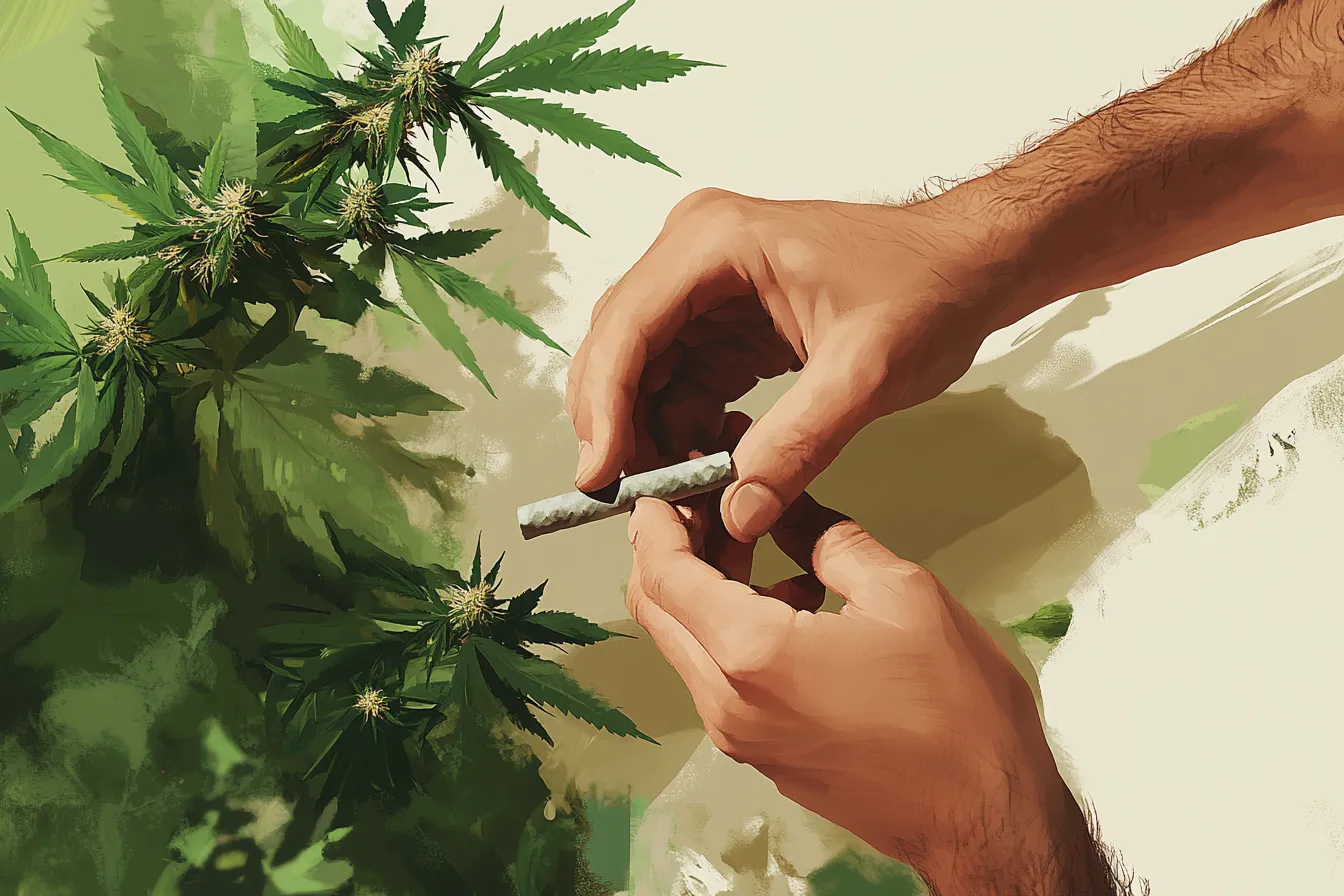
Cannabis may be consumed in a recreational and/or medicinal setting, where one can expect a duration of anywhere from one to 12 hours, depending on the form of consumption (for instance, edibles may have a longer duration than smoking). (52)
A cannabis high is frequently associated with altered sound and time perception, relaxation, increased appetite, laughter, anxiety, and more. High doses of cannabis can, at times, lead to hallucinations and psychosis, a sense of nervousness or unease, and physical symptoms such as vomiting and nausea (although lower doses can sometimes reduce nausea). These reactions are dose dependent and more common in new users, anxious subjects, and psychologically vulnerable individuals. (53)
When Does Cannabis Feel Psychedelic?
While historically classified as psychoactive, most reported effects of cannabis are not usually considered psychedelic. However, as mentioned above, consuming high doses of THC can potentially cause psychedelic effects.
One study titled – “Hallucinations” Following Acute Cannabis Dosing: A Case Report and Comparison to Other Hallucinogenic Drugs – from Cannabis and Cannabinoid Research looked into a scenario in which a healthy 30-year-old male experienced “auditory and visual hallucinations” after “inhaling vaporized cannabis that contained 25 mg THC.” (For context, the National Institute on Drug Abuse has defined a standard unit of THC as 5 mg.) The participant claimed to have experienced a “dissociative state” and compared the experience to a time “when administered ketamine before surgery.” (54)
Stephen Gray’s book, Psychedelic Cannabis, provides step-by-step instructions on using cannabis as a therapeutic tool, similar to other psychedelic therapies. (55)
There is little evidence that specific strains or forms of consumption of cannabis can make its effects more or less psychedelic. Although, it’s worth noting that THC in general, especially depending on dose, can have a psychedelic effect, in some cases even producing visuals similar to that which one might experience on a substance like psilocybin. Another thing to note when discussing this is that cannabis effects vary greatly from person to person, often factoring in past consumption habits, tolerance levels, height, weight, and more, as well as mental predisposition. While rare, cannabis-induced psychosis may happen. Anecdotally speaking, it is also possible for cannabis to rekindle a psychedelic state, especially if it is not long after the consumer has had such an experience with a substance like ayahuasca or mushrooms. (56, 57)
What to Expect During Your Cannabis Experience
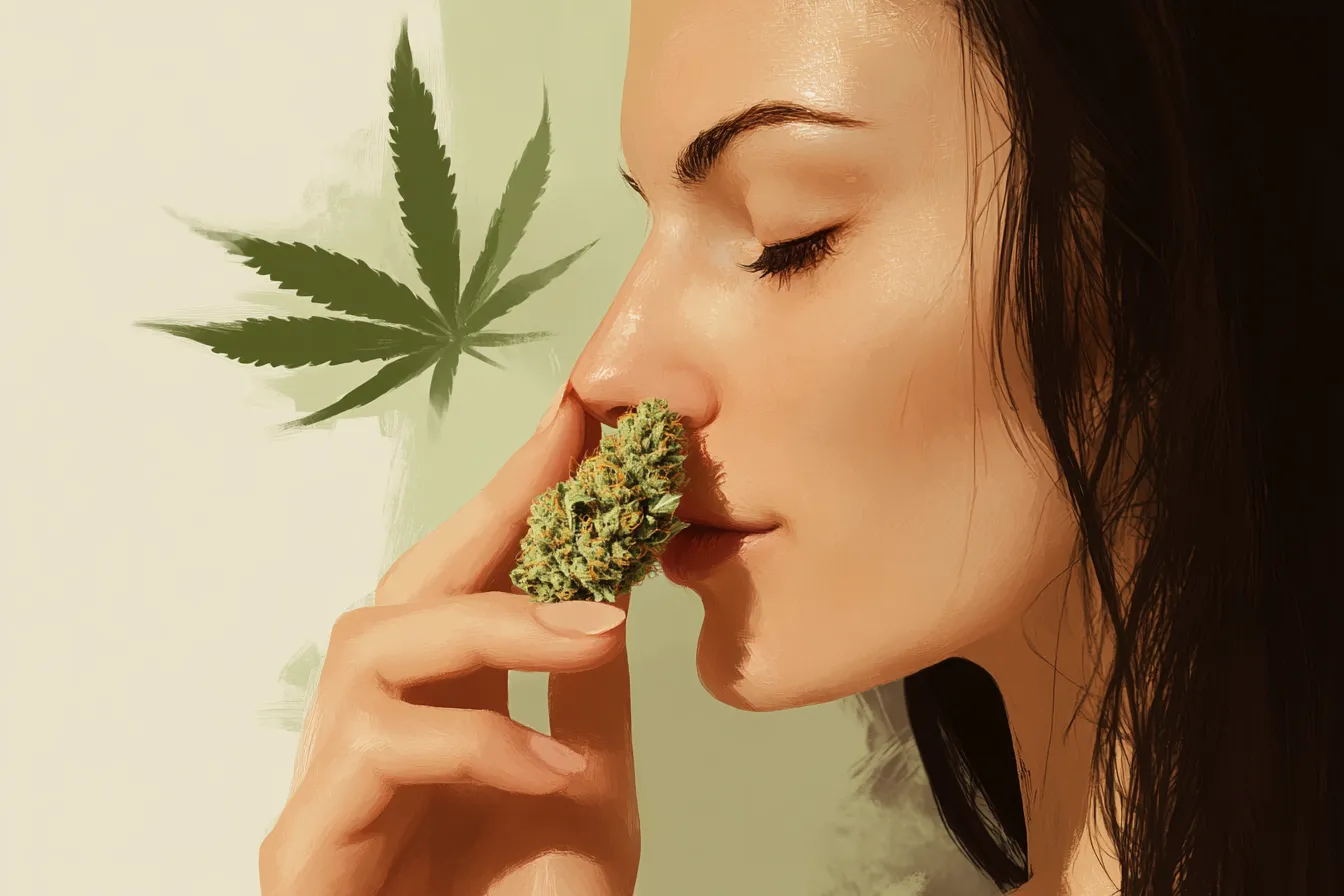
The cannabis experience, its duration and effects, can vary widely depending on the method of consumption and the strain consumed. However, like most other substances, it follows the same pattern of onset, peak, tapering, and aftereffects.
Here’s a brief timeline of what to expect during your cannabis experience if you are smoking or vaping it:
Onset: Immediate
After smoking cannabis, some effects will typically come on after minutes.
Peak: 30 min-2 hours
Depending on the strain, you may feel:
- increased euphoria
- A “body load” (sensations of heaviness or pressure in the body)
- Red eyes
- Dry mouth (often called “cottonmouth”)
- Increased levels of creativity
- Paranoia
- Worry
- Anxiety
- Hunger, known as the “munchies” (58)
Plateau: 2-4 hours after consumption
Two to four hours after smoking cannabis, you’ll likely be at a stable high. At this point, you may still be feeling the mental effects, although they might have tapered off a bit, including any physical effects.
Decline: 4-6 hours after consumption
Four to six hours after smoking cannabis, most effects will have faded. You may notice a decrease in your immediate euphoria, as well as any mental stimulation that you experienced.
Aftereffects: 6+ hours
The residual effects of smoking cannabis can vary based on the strain. You may feel some grogginess or fatigue. (59, 60)
Smoking Cannabis
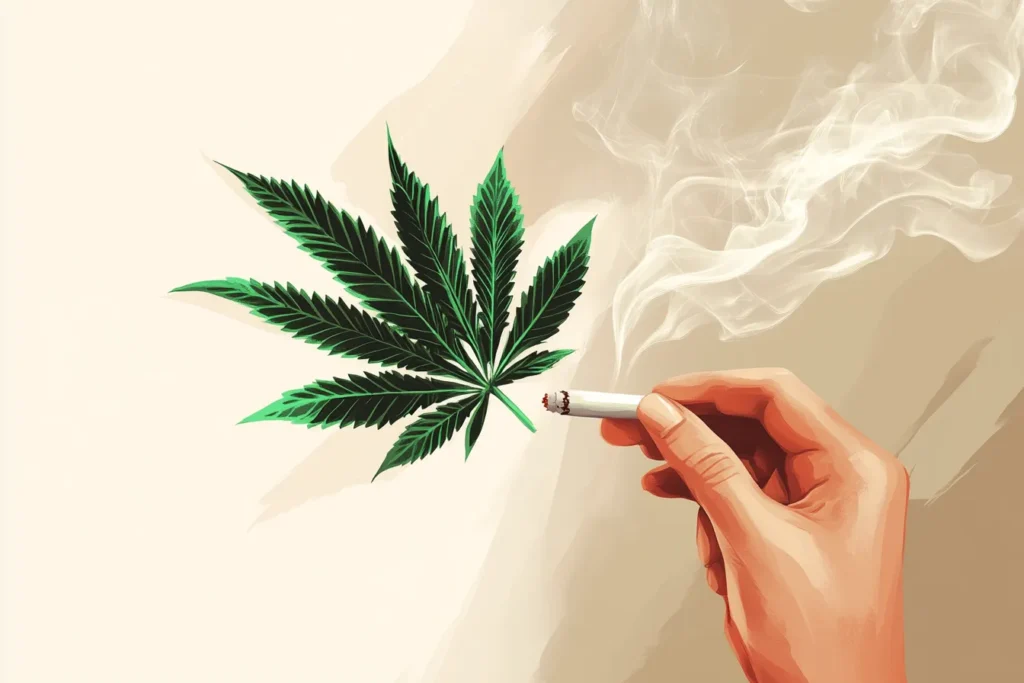
You can smoke cannabis in a rolled joint or blunt (a joint is a rolled cannabis cigarette held in by a thin paper, while a blunt is cannabis that’s been packed into a tobacco leaf holder like a cigar), a pipe, or through a bong (a type of water pipe). Typically, the effects of smoking cannabis follow the above timeline, with a peak around 30 minutes to two hours after consumption, and varied effects depending on the strain and the individual’s own physiological factors.
Vaping Cannabis
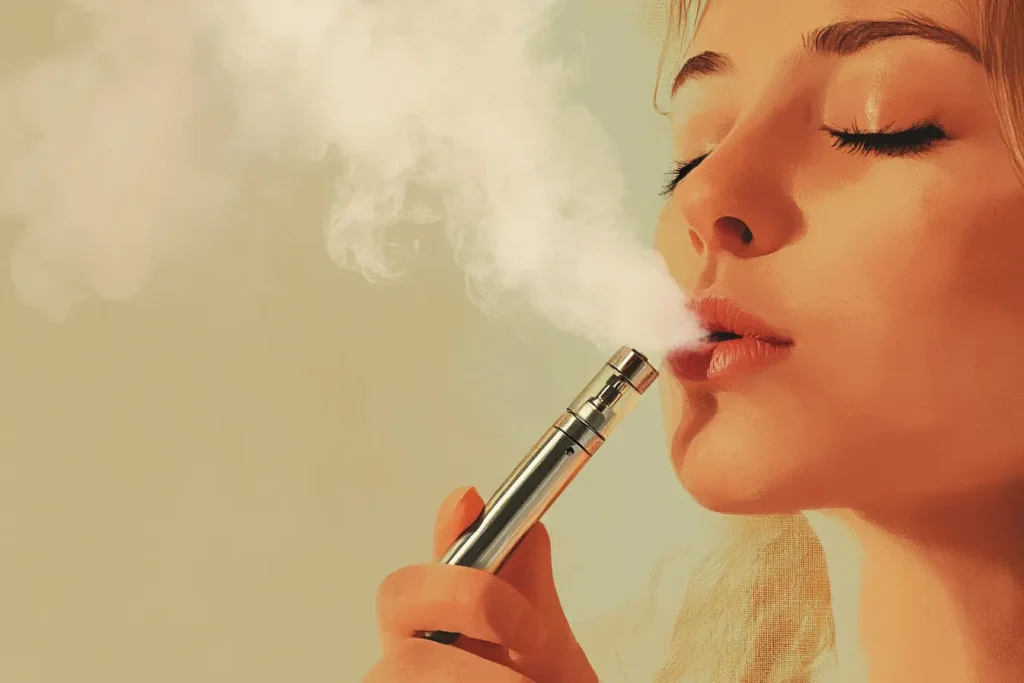
Vaping is the inhalation of an aerosol which is produced by heating liquid or solid forms of cannabis extract inside a vaping tool or accessory. Vaping still carries risks such as the possibility of heavy metals leaching into the cannabis extract and then being inhaled. (61)
When vaping cannabis you can expect to peak within about 15 minutes to one hour after consumption, and you might feel a surge of euphoria as opposed to a slow rise to it. You might find yourself back to normal within three to four hours. (62)
Cannabis Edibles
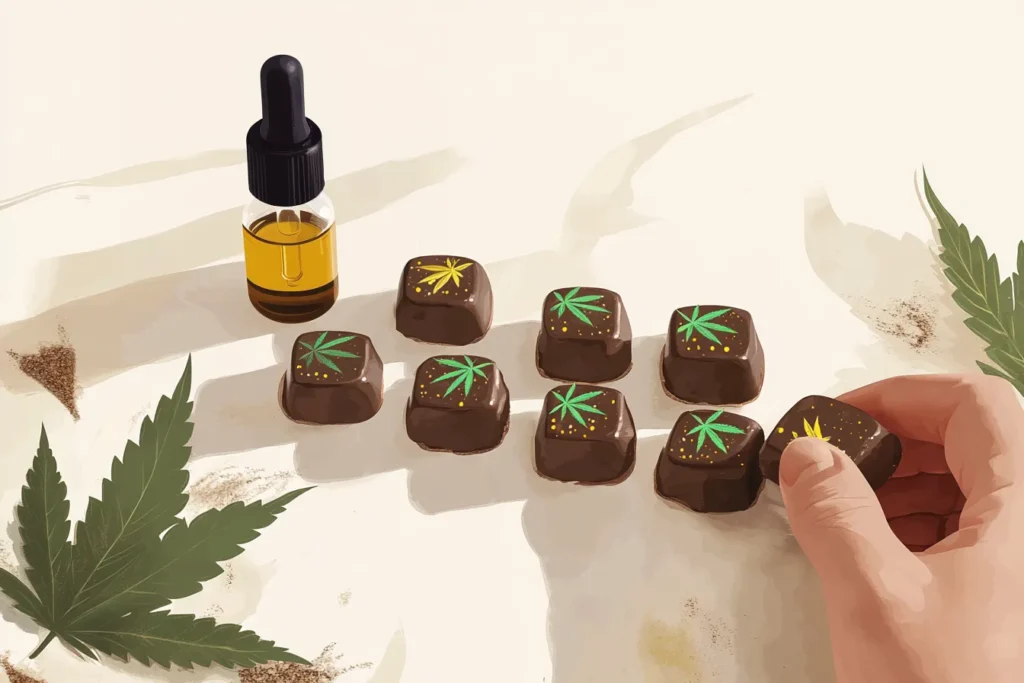
Cannabis edibles come in many shapes and forms such as: cookies, gummy candies, beverages, and chocolate bars. There have even been sightings of cannabis-infused ramen noodles. Cannabis edibles are made with either dried, infused flower or cannabis oils added to drinks and foods. (63)
The effects take around 30 minutes to two hours to come on. Edibles have a delayed onset time due to the digestive process. After consumption, the cannabis compounds must be metabolized before any effect can take place. If you take a cannabis edible and aren’t feeling anything within an hour, it’s best to wait before taking another one as the cannabis compounds may still be in the absorption process. (64)
With cannabis edibles, the effects slowly build over time. The peak will be around two to four hours after consumption, while users may maintain a stable high for about four to eight hours, sometimes even longer. (65)
How Long Does Cannabis Stay in Your System?
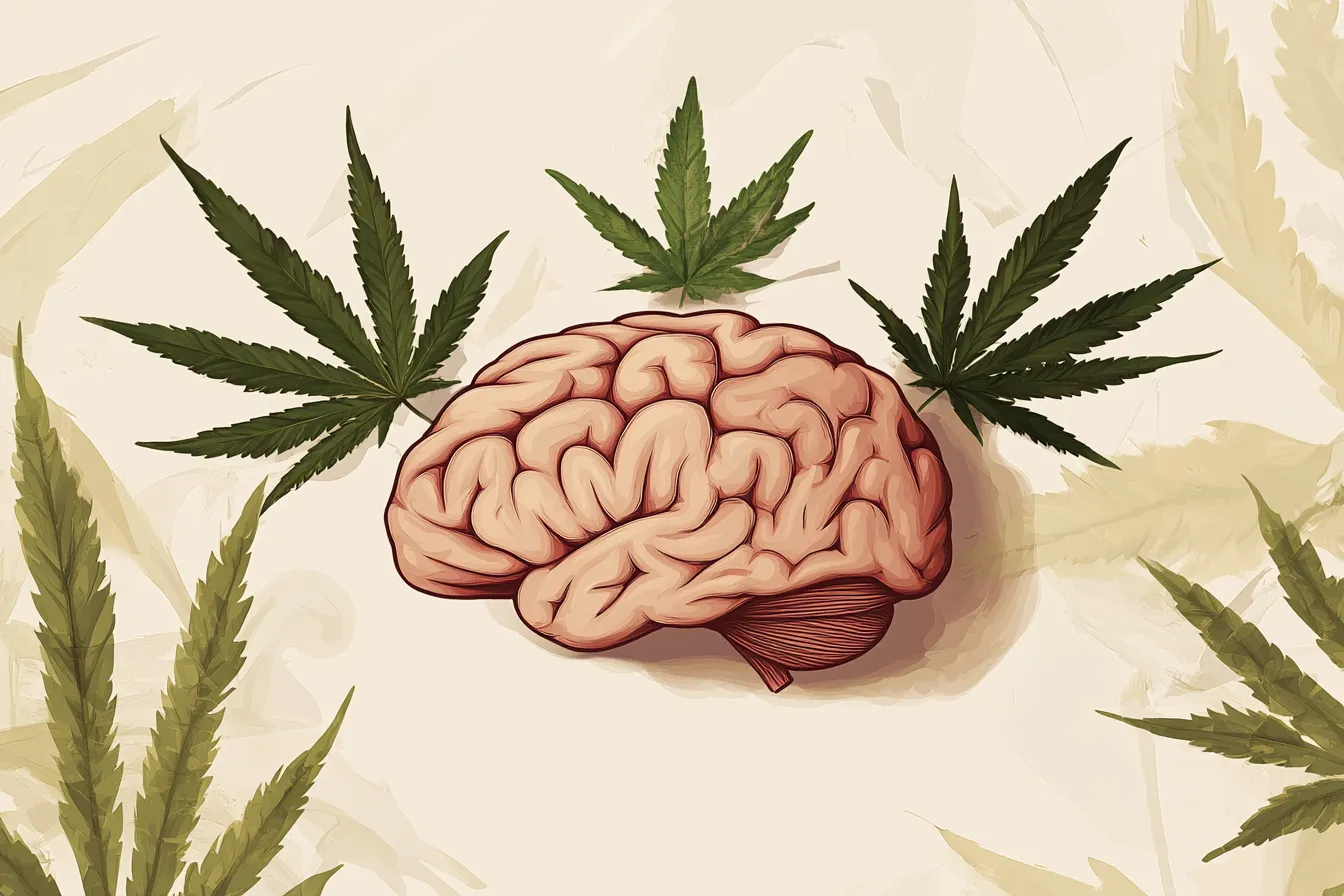
Cannabis metabolites bind to fat molecules in your body, which means that they can stay in your system for quite some time—even if you no longer have any effects.
THC can be detected:
However, many factors affect how long cannabis might be detected in your system after consumption, including dose, frequency (chronic users may have cannabis detected in their urine up to 30 days after consumption), the method of consumption, the potency of the cannabis, your metabolism, your BMI, and more. Cannabis compounds, especially THC, are fat-soluble. This means that people who have a high BMI, which oftentimes means a higher amount of fat on the body, may experience prolonged effects and slower onset of cannabis as it takes longer to release THC from the body’s fat stores. (67)
How Cannabis May Impact Psychedelic Experiences
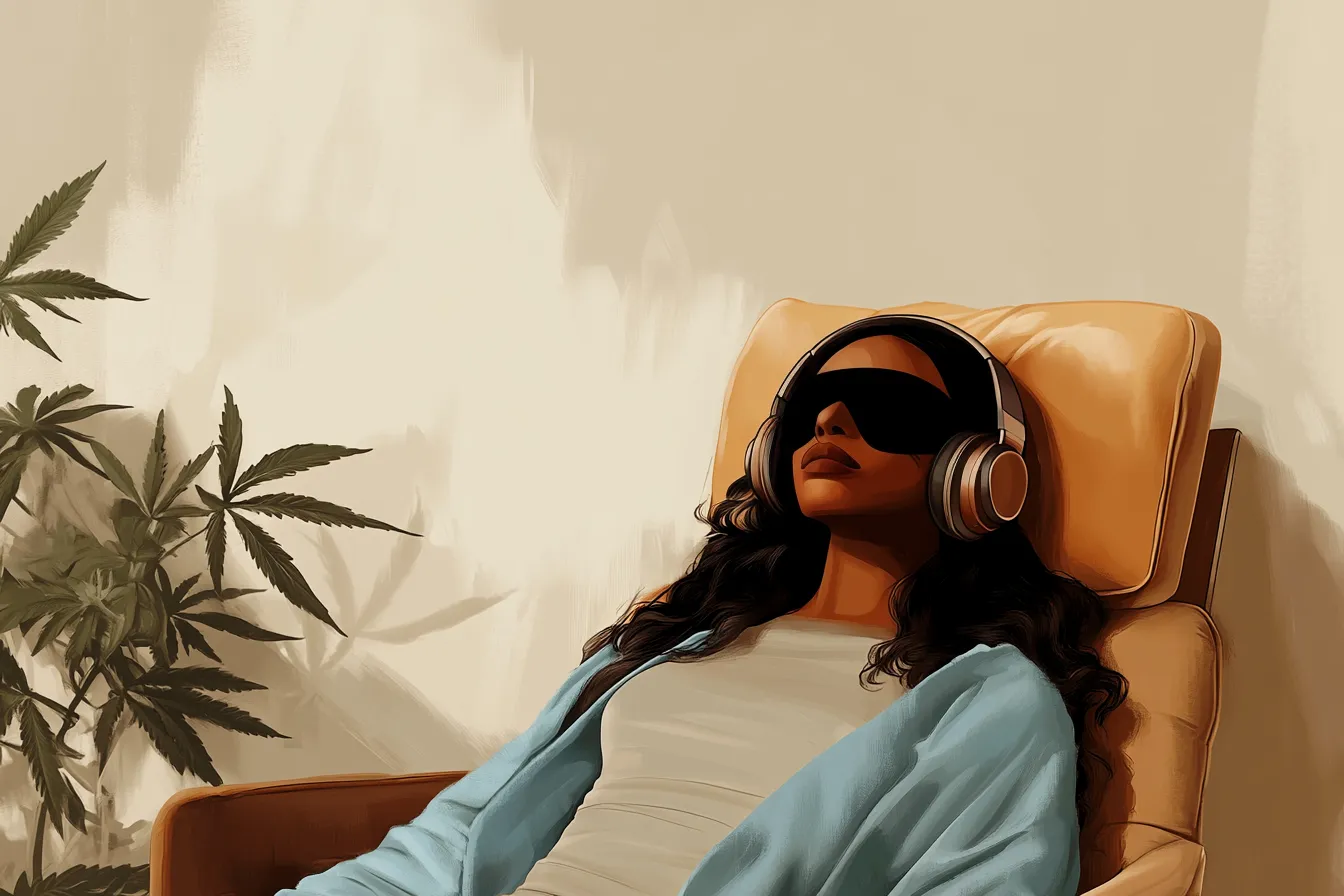
Being a psychoactive substance, cannabis has the potential to impact psychedelic experiences. A study from Imperial College London found that consuming cannabis with psychedelic substances like psilocybin, DMT, LSD, and mescaline increased the intensity of the original psychedelic experience. (67)
As seen in the journal Psychopharmacology, the use of cannabis alongside these substances was “associated with higher scores of mystical-type experience, ego-dissolution and visual alterations” and the experiences and intensity seemed to be dose-dependent. That is, the more cannabis a person consumed, the more intense the psychedelic effect was.
The same study found that users who did consume cannabis during their psychedelic experiences often had more “challenging” experiences, including feelings of fear and grief. This also proved to be dose-dependent. (67)
Of course, this is just one study, but mixing cannabis and psychedelics has been explored by psychonauts and drug users throughout time. Fireside Project, a non-profit peer psychedelic support line, released statistics in 2022 about the most common pairings people call them about, with psilocybin and cannabis taking the top spot with over 25% of callers. (68)
Cannabis has different effects when combined with other substances, and some of them shouldn’t be combined at all, or otherwise mixed with great care.
Cannabis and LSD
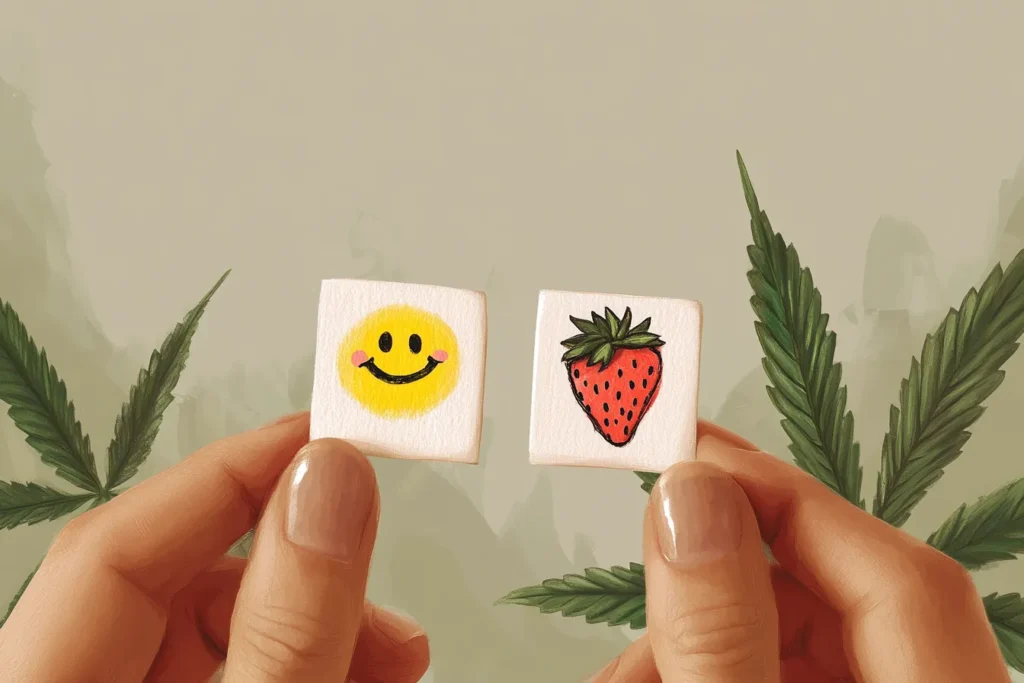
Mixing cannabis and LSD can lead to impaired decision-making ability. In terms of a physical health risk, an overdose on either drug is not particularly likely, but there is nonetheless a psychological risk. (69)
Anecdotal, some users report that they smoke cannabis at the end of an LSD trip to help counter the comedown or help them sleep afterwards, while others may consume cannabis during the psychedelic journey. Mixing the two may potentiate the effects of both drugs, which, for some users, can be an overstimulating experience. (70)
Cannabis and LSD are synergistic, which can make the hallucinations from acid more intense and powerful. Because of this, smoking at the end of the journey can sometimes bring users “back into it,” and induce additional hallucinations. Mitchell Gomez, executive director of DanceSafe, a nonprofit organization focused on drug safety education and harm reduction said in Vice interview that it’s “actually almost a joke within some psychedelic communities, a sort of classic mistake as you’re coming down off of LSD to be like, ‘Oh, I’m gonna smoke some pot and go to bed and then you do and now you’re like tripping again.” (71)
Cannabis and MDMA
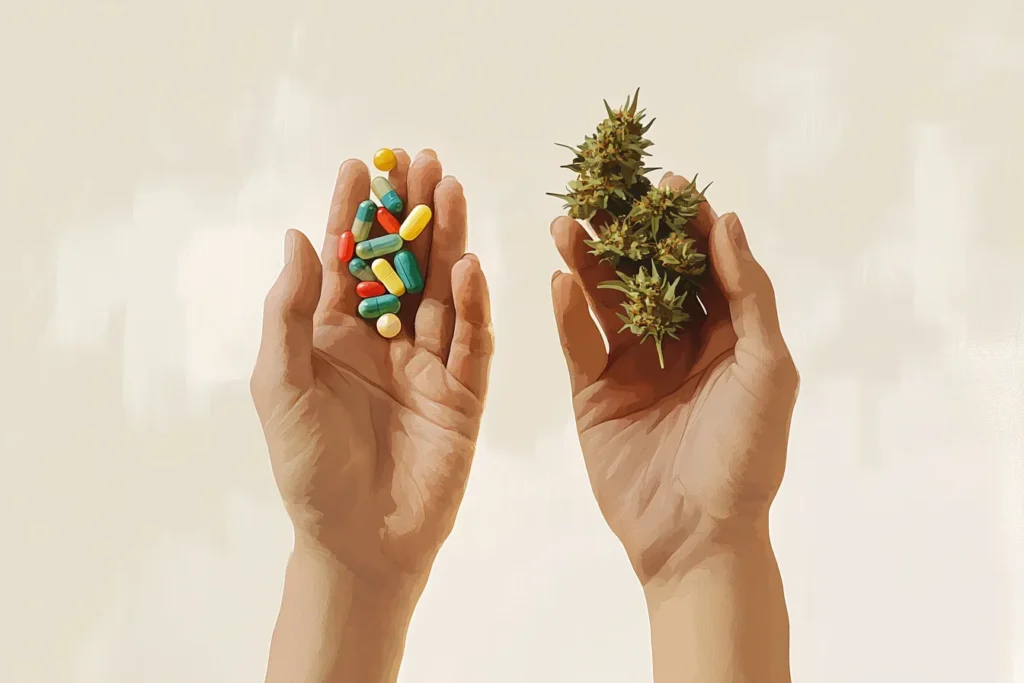
According to a 2007 study published in the Journal of Neural Transmission, the majority (90-98%) of “recreational” MDMA users also take cannabis. (72)
MDMA is a synthetic psychoactive compound, known as an empathogen. It often results in increased sensuality, sociability, intense euphoria, and very heightened sensory perception. MDMA may be associated with nightclubs, parties, music festivals, and other social settings. Some side effects include jaw-clenching, elevated blood pressure, overheating, anxiety, and muscle tension. Extreme cases can lead to serotonin syndrome and even death. (73, 74, 75)
Many people choose to consume cannabis as the effects of MDMA wear off, in order to mitigate the MDMA comedown. A 2003 World Psychiatry study states “Cannabis is a popular drug of choice in the rave subculture and is also taken by MDMA users to ameliorate the the ‘coming down’ period after MDMA use.” (76)
There are risks to mixing MDMA and cannabis. Cannabis use already leads to impaired cognition, and being affected by two substances at once can lead to even more impaired cognition, memory loss, and lack of information processing. Both substances lead to “racing heartbeat (tachycardia)”, and combining them could lead to an exacerbation of the same. (77)
Cannabis and Psilocybin
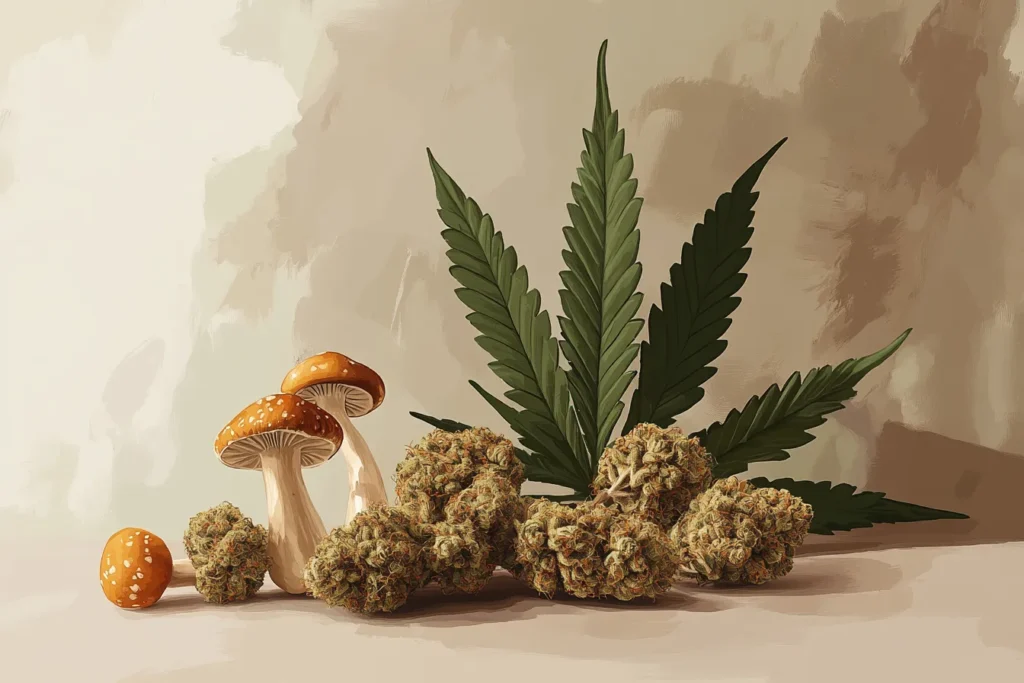
Mixing cannabis and psilocybin is common, as some of those who take the latter may at one point or another smoke a joint or eat a cannabis edible as habit, to potentiate the effects, or to calm down (depending on how well they know themselves, and can determine whether adding cannabis will make them feel more relaxed). A quick Google search for “mix cannabis and psilocybin” leads to hundreds of thousands of results, from anecdotal tales to magazine articles exploring the combo. Is it safe? Is it dangerous? What really happens when you mix the two? Just like most things with cannabis, it’s strain and dose-dependent. (78)
One can smoke cannabis before or after eating psilocybin to help with the nausea that often occurs from magic mushrooms. According to Healthline, clinical and anecdotal reports suggest that CBD-heavy strains of cannabis “can reduce the feelings of nausea,” as can THC-heavy strains—which, on the other hand, also may affect the intensity of the psychedelic experience, and even prolong it—which is what some people may want. (79, 80)
Safety-wise, both cannabis and psilocybin are relatively safe substances that don’t pose major health risks. Those who are experienced with each individually, and have a strong sense of how dosages affect them, might feel comfortable experimenting with mixing the two. Those without such experience, however, may want to show caution, as the combination can be intense. (81)
Cannabis and 2C-B
2C-B is a somewhat lesser-known psychedelic drug mostly used for recreational purposes. It has been anecdotally described as a gentle mix between LSD and MDMA. 2C-B was first synthesized by Alexander Shulgin, the Bay Area chemist who popularized MDMA, in 1974, and is known to have been his favorite substance. (82)
2C-B can produce hallucinogenic effects, alterations in perception, and mood changes, including euphoria and more. However, some reports of 2C-B use point to frightening hallucinations and anxiety. Cannabis, as mentioned, has the effect of heightening psychedelic effects, and as such may increase the strength of the trip offered by 2C-B. (83)
Cannabis and Mescaline
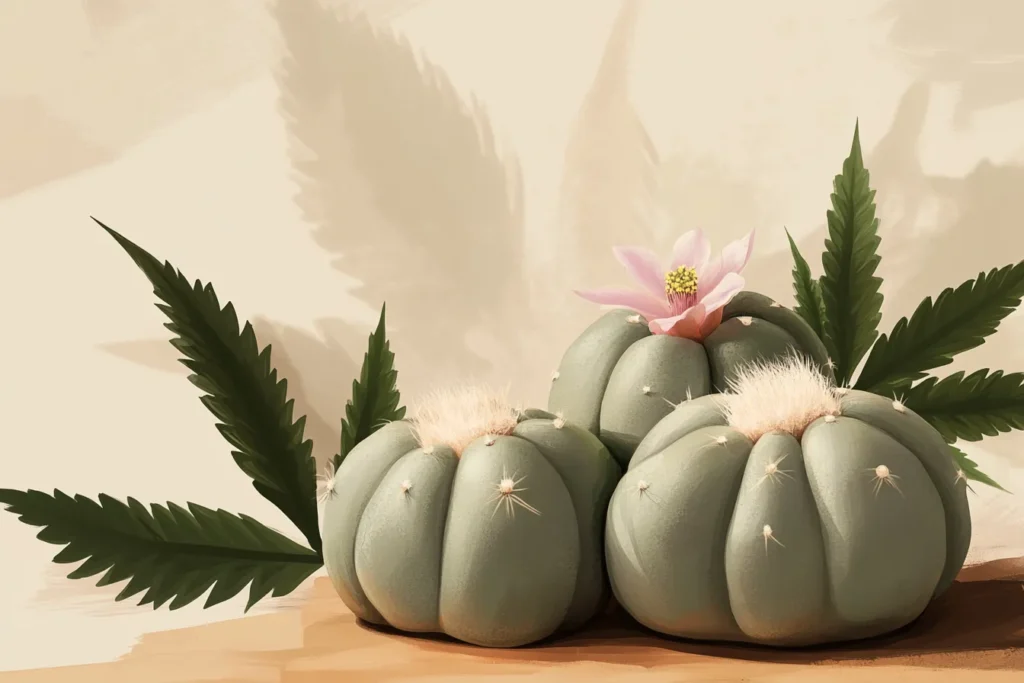
There is little research on mixing cannabis and mescaline, so most of what is known about this combination is largely anecdotal.
Mescaline is associated with a dream-like trip, visual hallucinations, euphoria, heart-opening, and slowed passage of time. It is also associated with nausea and vomiting. Some Reddit users report that consuming cannabis during the mescaline come-up can taper some of the nausea. (84, 85, 86, 87)
Cannabis and DMT
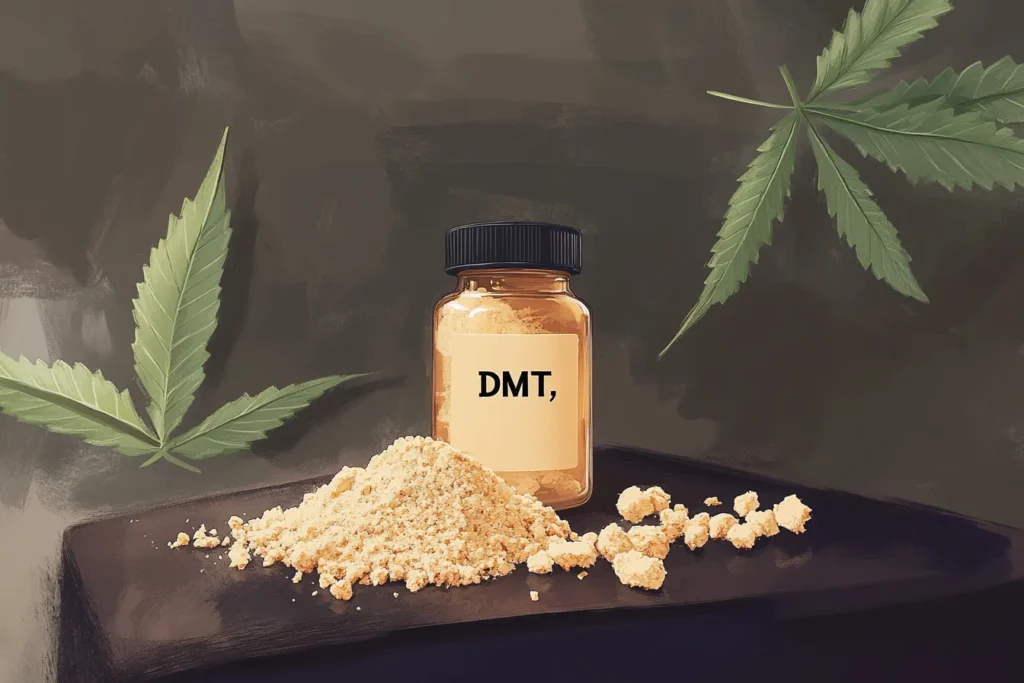
N, N-Dimethyltryptamine, or DMT, is a psychedelic compound found naturally in the human brain, as well as in some plants and animals. (88)
It is usually smoked or vaped, and has very strong hallucinogenic effects and visuals. Typically, a DMT trip is somewhat short-lasting compared to other psychedelics (even a strong dose will clock in at around 30 minutes). (88)
According to an online survey from the Imperial College London, consuming cannabis alongside many psychedelics, including mescaline and DMT, increased the intensity of the experience. (89)
Because DMT is known for its extremely rapid onset and intense effects, combining cannabis and DMT may be frightening for many users. (90)
One paper published in Psychiatry Research Case Reports describes a case in which the subject developed psychotic symptoms immediately after consuming a mixture of DMT and cannabis, concluding that DMT may worsen the symptoms of previous chronic cannabis use-induced mania. (91)
Cannabis and 5-MeO-DMT
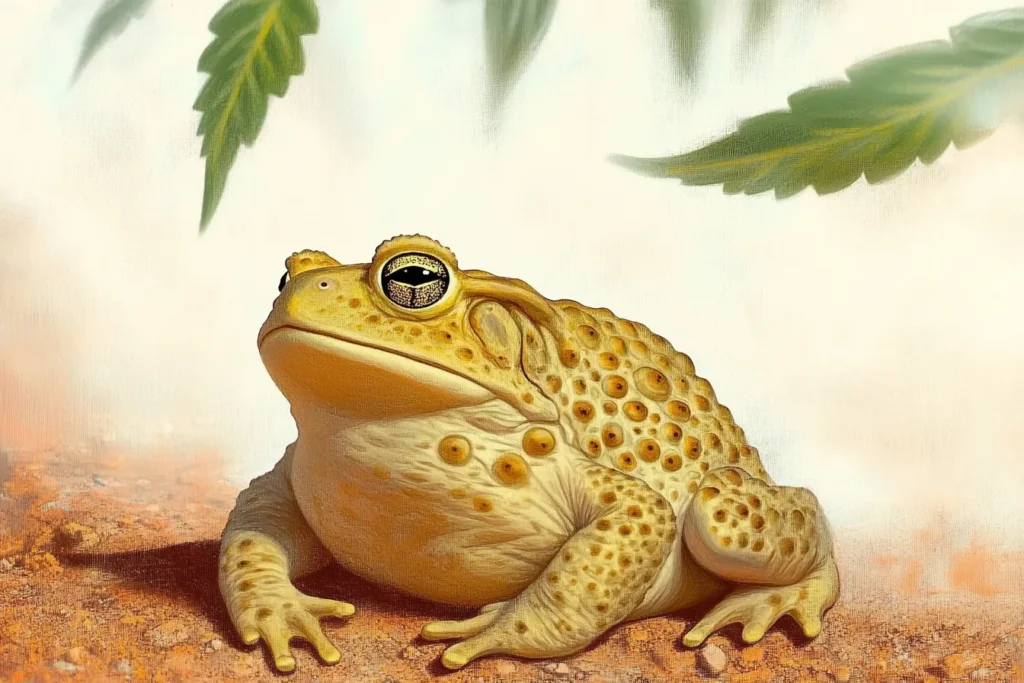
5-MeO-DMT is a powerful psychedelic tryptamine found in the venom of the Sonoran Desert Toad. It can also be lab-synthesized. It is usually smoked or vaped and provides an extremely intense and often dissociative psychedelic experience. It has a rapid onset and effects, which while radical, tend to be short-lived, with most smoked experiences lasting only about 10-25 minutes (however, snorting 5-MeO-DMT can allow effects to last up to two hours). (92)
5-MeO-DMT is often described as ineffable. The experience is all-encompassing and difficult to explain. Often, people who consume it lose their sense of self and control of their bodies. Therefore, combining cannabis with the 5-MeO-DMT experience would only be possible if the cannabis were consumed first, or after the dose has begun to wear off. (93)
Little evidence and research exists about this combination, so most information is largely anecdotal. According to the TripSit drug combination chart, mixing cannabis and 5-MeO-DMT requires a good deal of caution, especially since cannabis can have “an unexpectedly strong and somewhat unpredictable synergy with psychedelics.” In most cases, cannabis may intensify the psychedelic experience, or trigger the onset of psychedelic effects after they’ve begun to subside. (94, 95)
Despite similar names, 5-MeO-DMT is different from DMT and can be extremely frightening when the user is not prepared for it. Consuming cannabis before 5-MeO-DMT may either dull or intensify the experience. It is best to research both substances before moving forward with mixing these two.
Cannabis and Ayahuasca
Currently, cannabis is legal for adult use in nine countries:

Ayahuasca is an ancient psychoactive brew with a long history of being used for spiritual purposes by various Indigenous communities in the Amazon basin. Ayahuasca is a brew that is traditionally prepared with the Banisteriopsis caapi vine and one or several other plants, most often the Psychotria viridis shrub. The psychoactive effects of ayahuasca come from a DMT-containing plant, which is activated in the stomach by the caapi vine which contains alkaloids that act as monoamine oxidase inhibitors. This is what causes the psychedelic effects of the DMT to work, as, normally, DMT is not activated in the stomach and would just be digested. (96)
Cannabis may “potentiate” the effects of ayahuasca, which may intensify hallucinogenic experiences. That said, the combination also has the potential to increase anxiety. Cannabis may alleviate nausea associated with ayahuasca. However, there is limited evidence and research on this combination, and risks arise for people predisposed to psychotic disorders and cardiac issues. (97, 98, 99)
This is a simple overview of the potential effects when mixing cannabis and other psychedelic substances. It is also important to differentiate between high-THC and high-CBD cannabis strains, as users report that they will have drastically different effects on the combination. High-THC cannabis strains will most likely intensify psychedelic effects and prolong the journey, while high-CBD strains may reduce anxiety, especially while waiting for effects to kick in. (100)
Cannabis is, generally, physiologically safe to combine with psychedelics, but it can serve to make effects more prolonged and intense. If you’re considering mixing cannabis with other substances, make sure you first know their effects on your mind and body separately before blending. (99)
How to Make the Most of Your Cannabis Journey
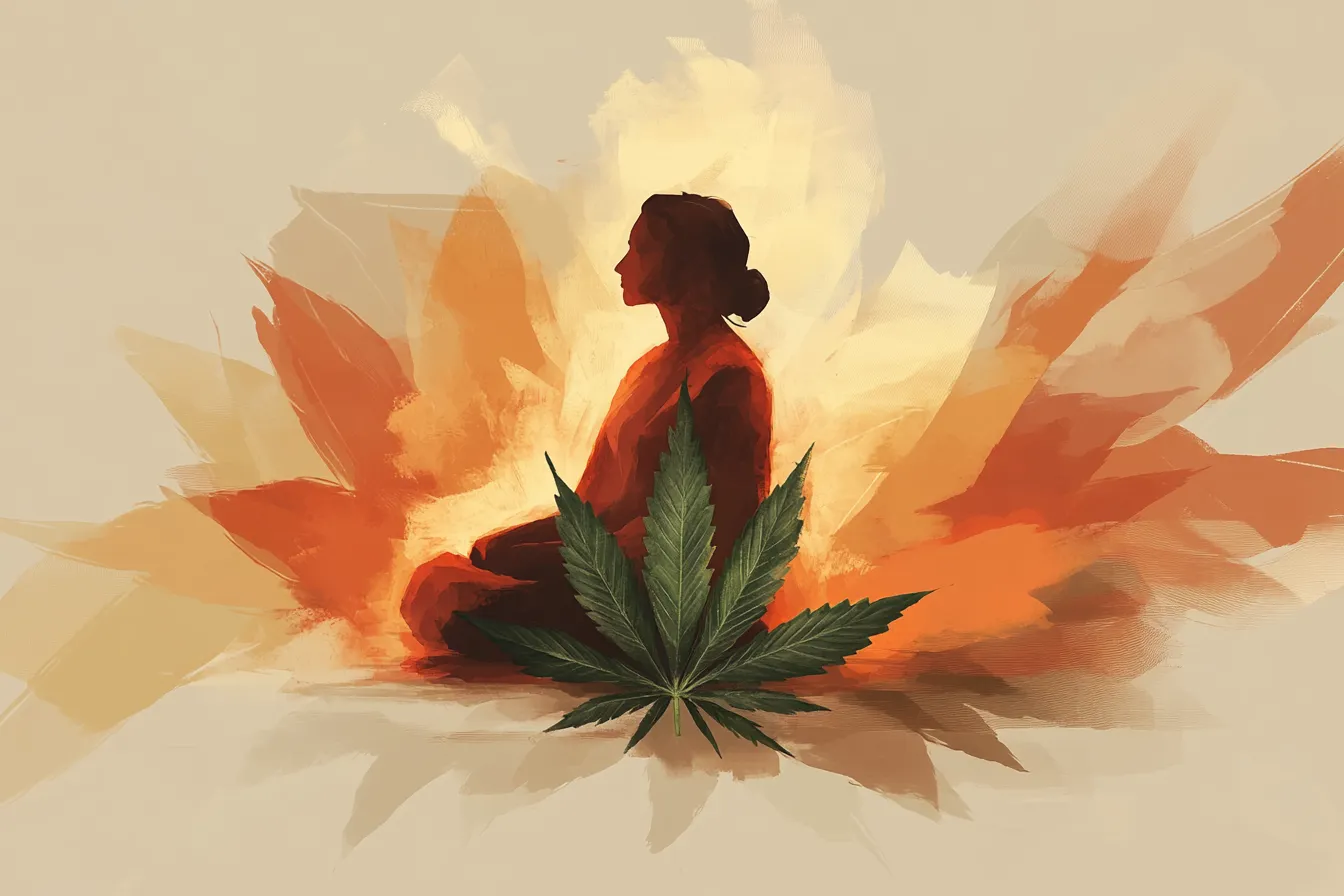
Some people use cannabis for medical purposes, while others may use it recreationally or spiritually. If used with intention, cannabis can be just as potent as any other substance—which means you may want to be intentional about the experience, as you would with a classic psychedelic such as psilocybin mushrooms. What’s unique about cannabis, however, is that while on another psychedelic such as psilocybin or ayahuasca, it might be difficult to do something like journal, on cannabis a person may have greater control of their physical faculties, which could allow the cannabis intentionality to start during the experience itself.
Here are a few ways to incorporate cannabis into your integration practice:
Additionally, here are some tips for intentional, mindful cannabis use:
Benefits and Potential Medical Use of Cannabis
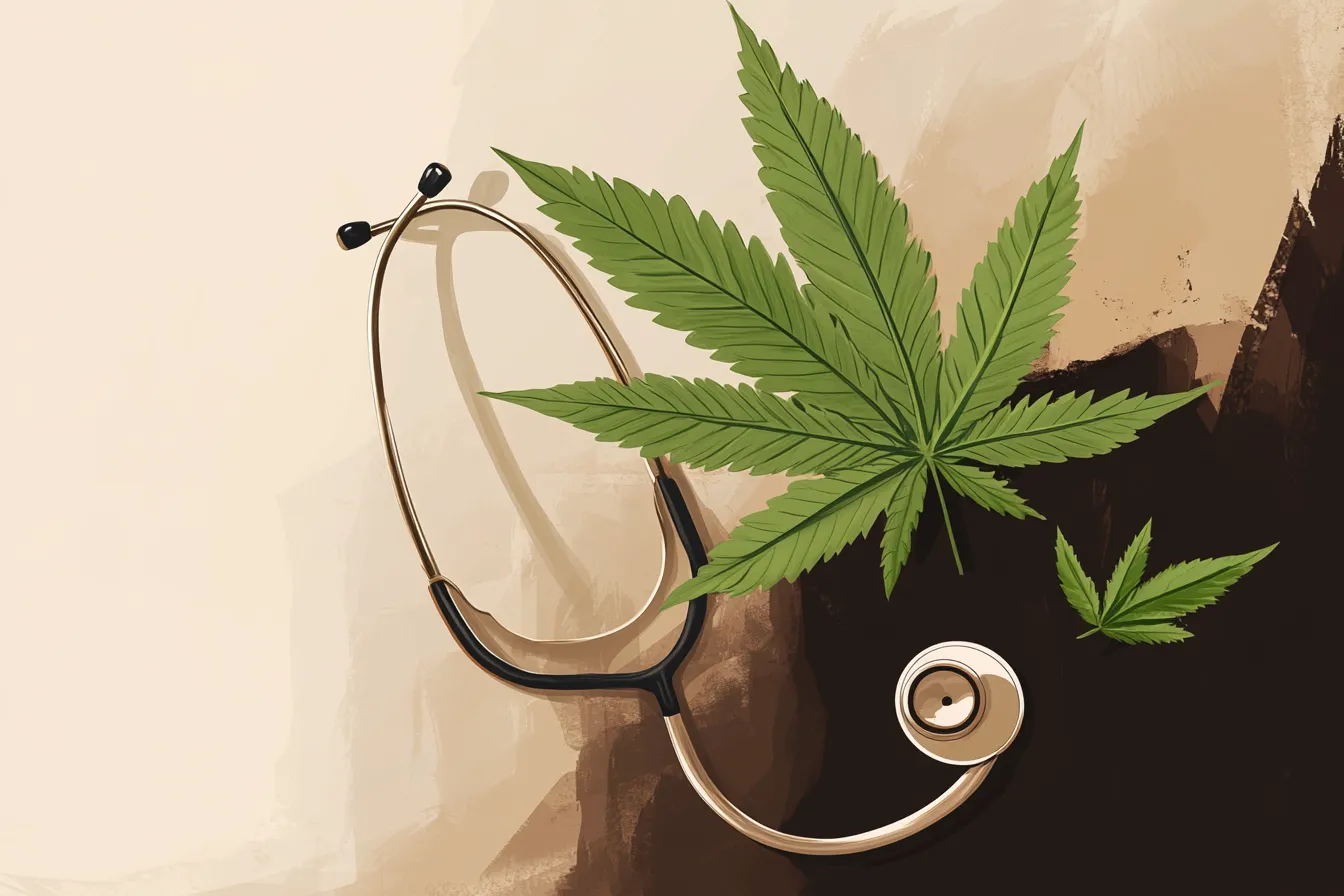
Various cannabinoids, especially THC and CBD, have been used therapeutically and medicinally. In some cases, cannabis has been used with great success to treat seizures, convulsions, nausea, chronic pain, or other side effects of chemotherapy. It is often used as a tool to simulate appetite for cancer patients experiencing nausea from chemotherapy, and in the synthetic FDA approved form known as Marinol/Dronabinol, THC can also help with cancer related nausea and vomiting. (101, 102)
Cannabis can be prepared and extracted in many ways, and, therefore, its functions vary significantly. According to a German study published in Deustche Artzeblatt, therapeutic cannabis preparations can have “antispastic, analgesic, antiemetic, neuroprotective, and anti-inflammatory actions, and are effective against certain psychiatric diseases.” (Grotenhermen, Muller-Vahl) (100)
Cannabis’ Medical and Psychotherapeutic Applications
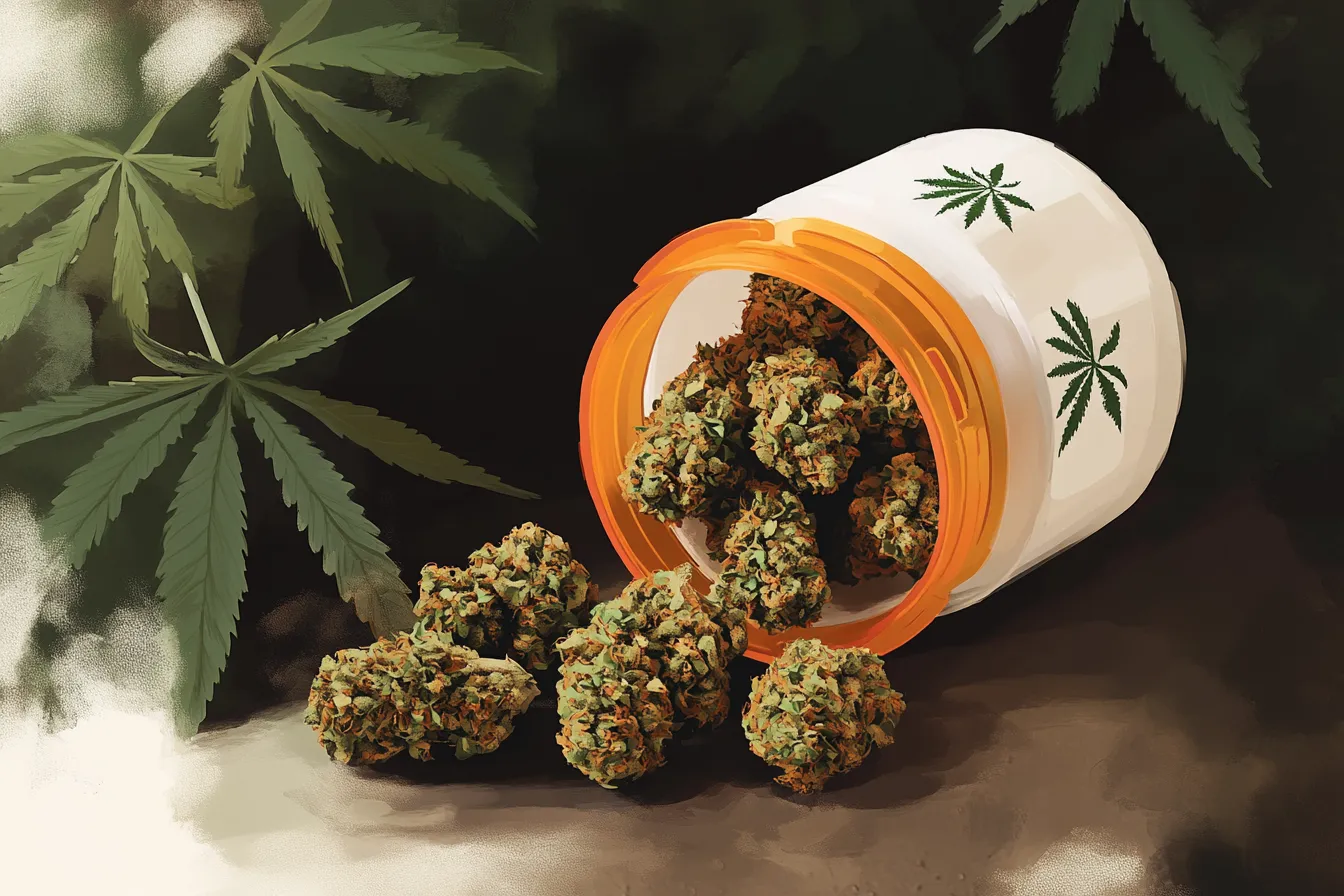
There have been several studies and clinical trials exploring cannabis’ potential medical and psychotherapeutic uses. Both clinical and anecdotal evidence points to cannabis’ potential efficacy in treating the symptoms of various physical and psychological disorders, helping with things like nausea, pain, anxiety, sleep, and so forth.
Chemotherapy
THC has been seen as “highly effective” for the treatment effects of chemotherapy, such as nausea, vomiting, and lack of appetite. A 2022 study found that “High levels of cannabidiol (CBD) use during the two-week ad libitum use period was associated with steeper improvements in pain intensity and sleep quality.” (101)
Chronic Pain
According to one study, 94% of Colorado medical marijuana ID card holders list “severe pain” as the medical condition for which they need medical cannabis. “Relief from chronic pain is by far the most common condition cited by patients for the medical use of cannabis” the study states in an article published in NIH’s National Library of Medicine. (102)
When combining the information across various studies, there is some evidence to suggest that cannabis may be a supportive tool for chronic pain in adults. (103)
Multiple sclerosis
People suffering from MS may deal with spasticity, which refers to stiffness and muscle spasms and contractions. There is some evidence to suggest that cannabinoids may be effective in treating multiple sclerosis “spasticity” symptoms, however, according to the National MS Society, “Cannabinoids are not currently recommended for use in MS-related ataxia, tremor, or sleep dysfunction.” (104)
Sleep disorders
Cannabis and its varied cannabinoids are often used as sleep aids. There is some clinical evidence for this, suggesting that short-term cannabis use can assist with sleep issues. A 2022 study published in the Canadian Pharmacists Journal shows that cannabis use may improve sleep scores, with 71% of a small study group reporting a “subjective improvement” in their sleep. Clinical and anecdotal evidence points to cannabis both helping consumers fall asleep faster, as well as aiding in some of the sleep disturbances associated with PTSD. (105, 106, 107, 108)
Parkinson’s
Parkinson’s Disease is the second most common neurodegenerative disorder in the U.S. According to the Parkinson’s Foundation. Evidence for medical cannabis for Parkinson’s is limited and not completely understood, as trials have been small. The Foundation’s official stance is that research is still needed to see how medical cannabis can help with Parkinson’s. The Foundation’s National Medical Advisor, Dr. Michael Okun, said that “marijuana should never be thought of as a replacement for dopaminergic and other approved therapies for PD.” (109)
Opioid Use Disorder
There are some studies on the effects of cannabis and cannabinoids for the treatment of opioid use disorder and issues stemming from long-term opioid use, including chronic pain. One study from Frontiers in Pharmacology focusing on medical cannabis for opioid users found that in 600 users, 26% had stopped using opioids, while 55% “had reduced their average opioid use by 30%.” There is emerging evidence that cannabis could be potentially used in the treatment of opioid use disorder, but there is also a concern that the replacement could lead to cannabis use disorder. (110, 111)
Anxiety
There has been some research exploring medical cannabis for the treatment of anxiety disorders. CBD has specifically been identified as having anxiolytic (anxiety-reducing) properties and may even help people without any of the negative side effects, such as paranoia, sometimes associated with THC use. (112, 113)
Cannabis Legal Status and Regulations
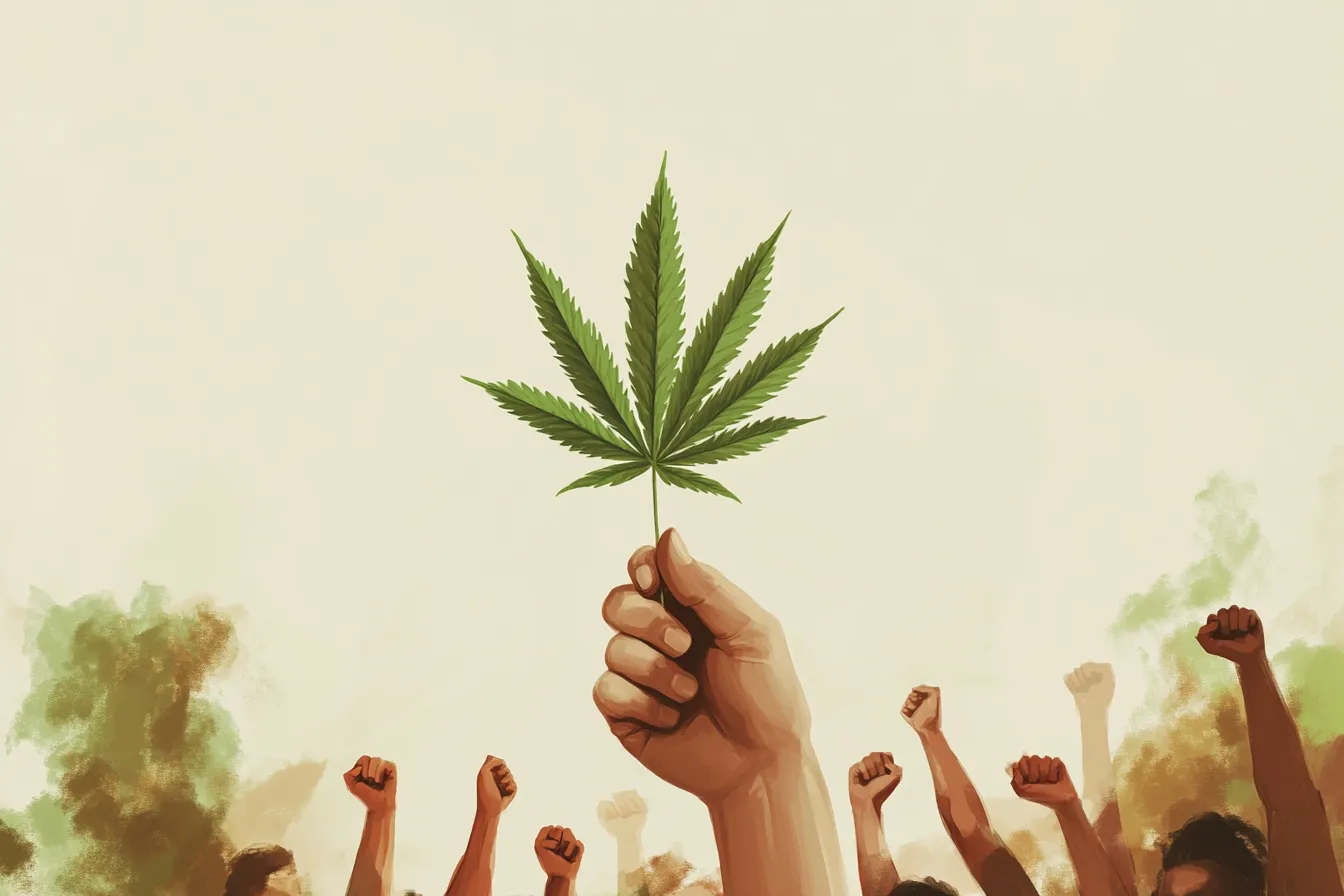
Legal regulations around cannabis are quickly and constantly changing, so you should always check the laws in your jurisdiction.
| 🇨🇦 | Canada |
| 🇲🇽 | Mexico |
| 🇵🇾 | Paraguay |
| 🇩🇪 | Germany |
| 🇬🇪 | Georgia |
| 🇿🇦 | South Africa |
| 🇲🇹 | Malta |
| 🇲🇽 | Thailand |
| 🇱🇺 | Luxembourg |
| 🇺🇾 | Uruguay |
| 🇦🇺 | The Australian Capital Territory of Australia. |
Decriminalization is the removal or reduction of criminal penalties for acts that were previously considered criminal behavior, although as a policy it falls short of a full legalization and civil penalties may still apply. Some states and counties in the U.S. have opted to decriminalize cannabis instead of legalizing it. State decriminalization of cannabis has resulted in the removal of criminal penalties for personal possession, but that does not apply to federal law. Additionally, decriminalization of possession does not include the sale of cannabis, and cannabis remains outside of a regulatory system. For example, a decriminalized jurisdiction will not have a cannabis store, but a legalized one may, and will impose taxes on the cannabis. (114)
Countries that have decriminalized cannabis include:
| 🇵🇹 | Portugal |
| 🇨🇿 | Czech Republic |
| 🇦🇷 | Argentina |
| 🇳🇱 | Netherlands |
| 🇿🇦 | South Africa |
| 🇪🇪 | Estonia |
| 🇧🇪 | Belgium |
There are many factors that influence cannabis’ legality across the world, from changing social perspectives to ongoing and newfound research. Interest in cannabis and varied cannabinoids as a therapeutic and medical tool has opened up the door for the recognition of the benefits of cannabis, leading to legalization or decriminalization and access to medical cannabis for those who need it. Cultural factors, political leadership, global treaties, and regulations and frameworks all play a role in whether or not countries and leaders choose to legalize cannabis or not.
Arguments for legalizing cannabis globally tend to point towards its potential medical and economic benefits. Looking at Canada and Thailand as examples of domestic and tourist economic booms; we see that following legalization, cannabis has contributed over $43 billion USD to Canada’s GDP and is expected to be at around $1.2 billion USD in Thailand in 2025. That said, whether there is drug policy reform or not, more education and attention to harm reduction is needed. Indeed, studies have shown that cannabis legalization does not increase youth and teen cannabis use, and in fact, can lead to lower odds of cannabis use among young people. (115, 116)
Arguments against cannabis legalization may center around cultural, religious, or public health concerns, citing the ongoing “Gateway Drug Theory,” which suggests that cannabis consumption opens a door to harder drug use later on. On both sides of the cannabis policy reform debate, advocates cite concerns about lack of regulation and oversight, negative impact on small communities, an increase of crime, and more.(117)
In the United States, until recently, cannabis has been federally illegal, although some research institutions such as the Multidisciplinary Association for Psychedelic Studies (MAPS) have been able to get government approval to study cannabis—in this case, for example, a $12.9M grant to research cannabis for veterans with PTSD. (118)
This past May, however, the Biden administration reclassified cannabis as Schedule III, where the potential for abuse is listed as “medium.” This should make research easier to conduct. However, cannabis advocates argue that rescheduling still leaves a large segment of the industry at risk or criminal penalties for conducting business outside the federally medical paradigm. (119)
Cannabis is legal in 38 states to varied degrees, with 24 states, like California and Colorado, having legalized adult use, and the others, like Florida, only having legalized medical cannabis use and hemp-derived cannabis products, such as CBD, delta-9, or delta-8 THC. Some states have specific restrictions on qualifying medical needs for medical marijuana.
States where cannabis is legal for adult use include:
States where cannabis is decriminalized include:
Cannabis legalization, decriminalization, and regulation remain a hot-button topic in the U.S. and are often at the forefront of elections in both federal and state legislatures.
Blazing a Trail: Cannabis and Psychedelic Legalization
The current American movement to legalize or decriminalize psychedelics has been largely influenced by the cannabis policy reform movement.
States like Colorado and California, which were early adopters of legalizing medical and adult use of cannabis, were among the first to consider decriminalizing psychedelics and exploring their potential therapeutic use.
Cannabis decriminalization and legalization have shifted cultural perceptions and perspectives on various substances and their uses. Robert Johnson of Rolling Stone writes that public opinion “is shifting on psychedelics, with decriminalization statutes passed not only in blue-state capitols and liberal college towns, but in places like Oklahoma and New Hampshire. The Oklahoma measure, for example, authorizes research institutions to obtain psilocybin to study its potential efficacy for PTSD, depression, anxiety and addiction.” (121)
Similarly, cannabis legalization has opened the doors to more research on its therapeutic and medical use, which has, in turn, created opportunities for similar research for psychedelic substances.
Many psychedelic advocates are looking for decriminalization rather than legalization. They argue that rather than instituting a paradigm of legal shops, frameworks, and regulations, which by default, come along with punishment for those operating rogue, instead people should have the freedom to grow and consume psychedelics on their own without fear of legal repercussions. This is the position of the Decriminalize Nature movement to decriminalize psychedelic plants in various localities across America. (122)
Current legislation around psychedelics is limited in America, but growing. In 2019, Denver became the first jurisdiction to decriminalize psilocybin. In 2022, Colorado decriminalized five psychedelics: DMT, mescaline, psilocybin, psilocin, and ibogaine, for personal use. Several other cities have followed suit. (123)
While most psychedelics remain federally illegal in the U.S., MDMA and synthetic psilocybin have been placed on the FDA’s fast track to become prescription medications in psychedelic assisted psychotherapy. “Breakthrough therapy” is a classification by the Food and Drug Administration (FDA) of the USA that helps expedite drug development.
In late 2023, MAPS submitted a claim to the FDA to consider MDMA-assisted therapy for breakthrough therapy status. In June 2024, an external FDA advisory committee voted against MDMA-assisted therapy, and in August 2024 the FDA rejected it, recommending another round of Phase III trials. (124)
In 2024, the FDA granted breakthrough status to an LSD formula by drug developer company MindMed for the treatment of general anxiety disorder. (125)
Microdosing Cannabis
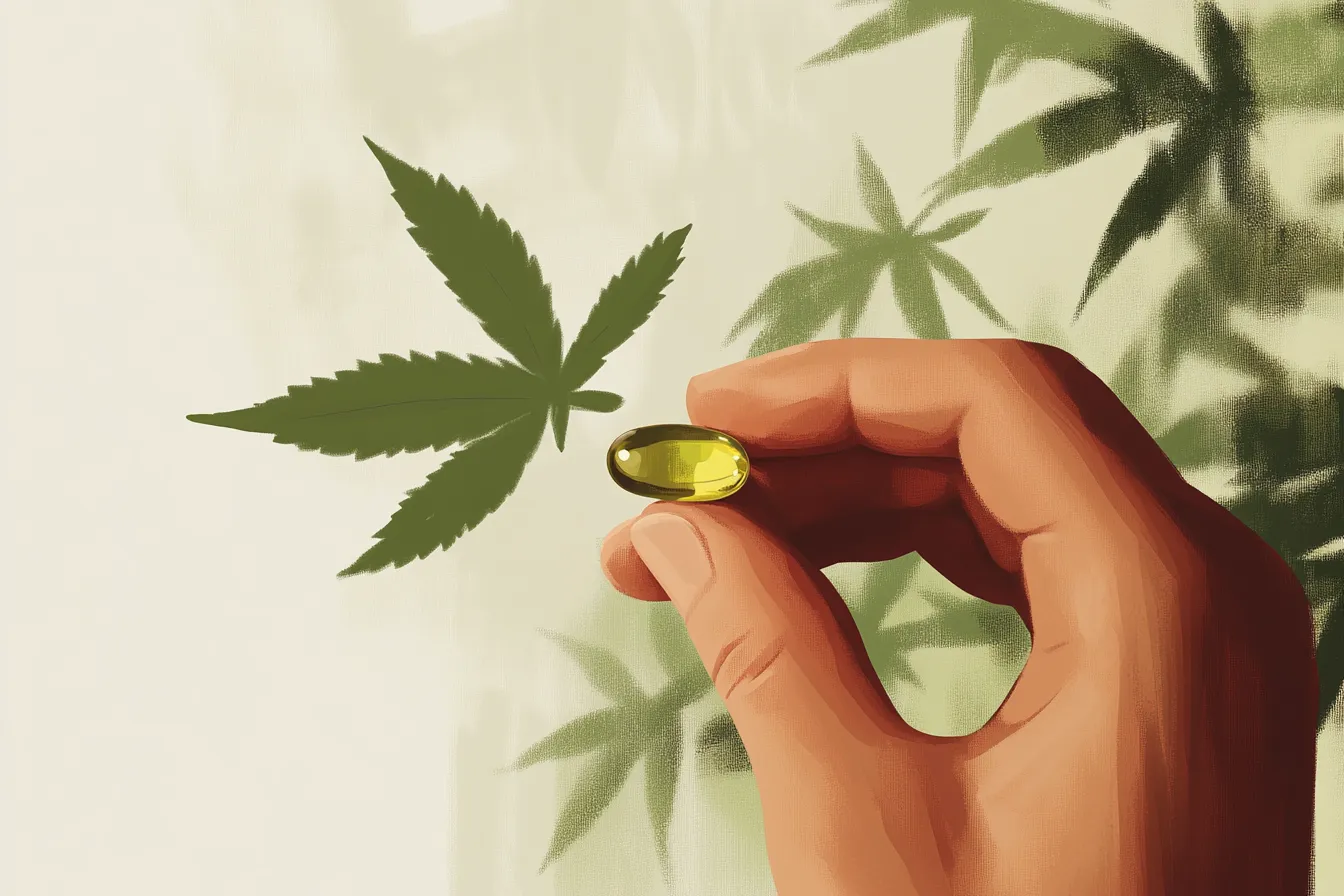
The concept of “microdosing” cannabis is fairly new and not always associated with cannabis the way it is with substances like psilocybin or LSD.
According to Canadian medical marijuana provider Apollo Cannabis, microdosing cannabis started gaining popularity in Canada after legalization in 2018, and kept gaining traction since. (126)
Microdosing refers to taking small, sub-perceptual (meaning that the effects are so subtle that one can’t feel them overtly, although they do have some influence on cognition) doses of a substance a few times a week on a regular basis. Usually a microdose is about 1/10 or 1/20 of a regular dose.
In the case of cannabis, microdosing may be ideal for consumers who may become too overwhelmed by moderate or high doses. In one study from 2012, patients with cancer for whom opioid painkillers were not working instead tried a THC/CBD compound at low, medium, and high doses. Those with the lowest dosage of cannabinoids showed the greatest reduction in pain, while those who had higher doses were actually reported to be in more pain. Another study found that low doses of THC produced stress-relieving effects for participants. As renowned internist Dr. Allan Frankel stated in Rolling Stone, “A quarter of my patients are taking [a microdose of] less than 3 mg of THC a day,” which he called the “correct dose.” Saying, “In all medicine, with all drugs, you look for the minimum effective dose.” (127, 128, 129)
Unlike microdosing mushrooms and LSD, there is no generally agreed upon standard of what constitutes a cannabis microdose. Each person’s tolerance to cannabis is different, and each strain also offers varied experiences. Additionally, the sensation will vary depending on whether one is confusing THC alone or with CBD. However, starting with 1 mg of THC is likely a safe bet, especially for novice consumers. For experienced consumers, Dr. Sulak, a cannabis specialist doctor, recommends 48 hour tolerance break before starting a microdosing regimen. (130)
Smoking cannabis may be a difficult way to dose THC appropriately, so some doctors recommend cannabis oil and tinctures or edibles for a better, more controlled cannabis microdosing experience. (130)
Cannabis Side Effects and Contraindications
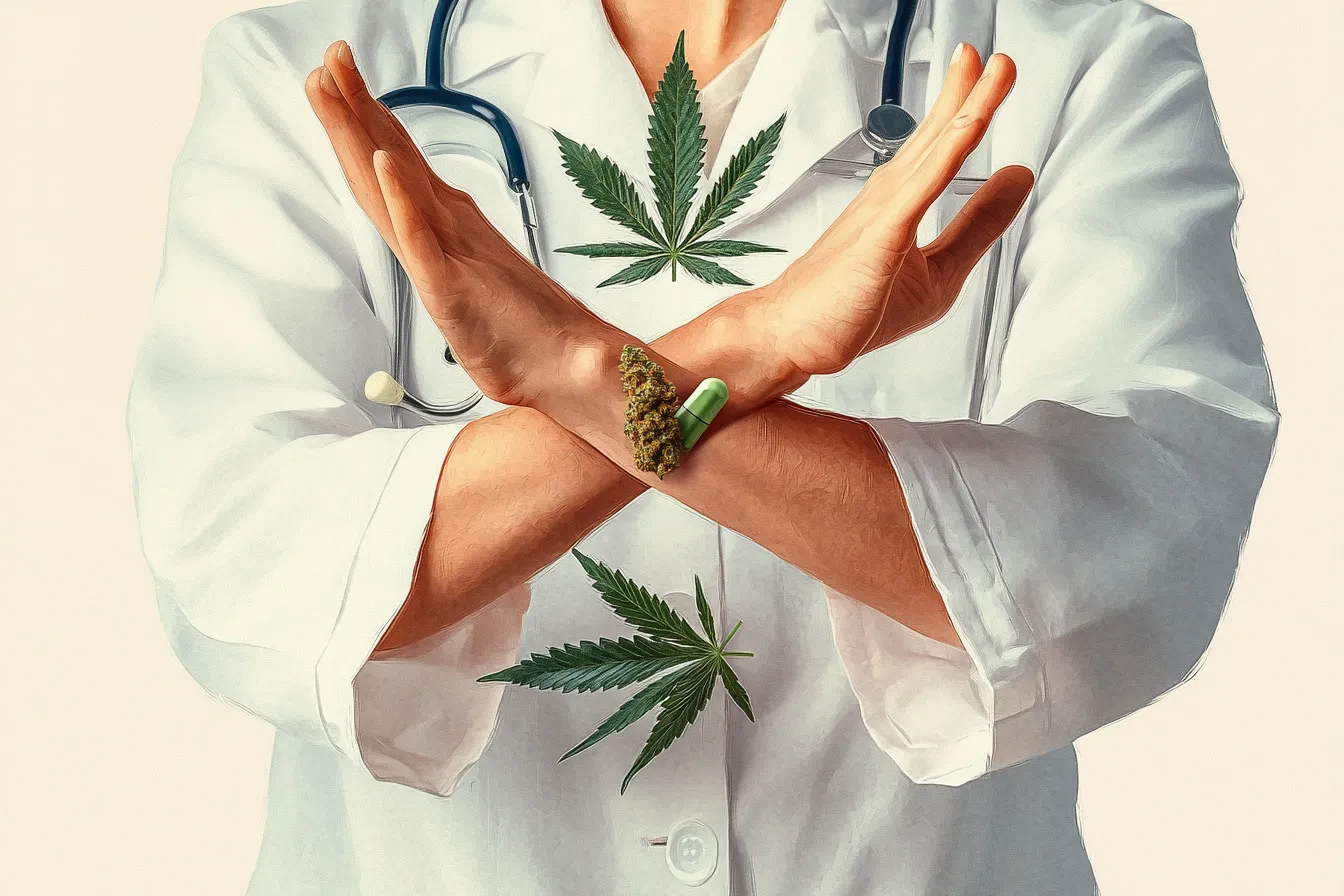
As one of the world’s most commonly used substances, cannabis’ side effects are fairly well known. Below are some common short and long-term cannabis side effects.
Short-term Adverse Cannabis Side Effects
Long-term Adverse Cannabis Side Effects
Contraindications Between Cannabis and Other Medicines
According to a 2020 study from the Canadian Medical Association Journal, cannabis can have serious interactions with some drugs, including:
While cannabis is nonlethal, it can still present contraindications for certain populations. For instance, people with cardiopulmonary disease may be at increased risk due to the respiratory effects associated with smoking cannabis. Studies show that inhaling cannabis smoke can lead to increased airway resistance and may exacerbate conditions such as chronic obstructive pulmonary disease (COPD) and asthma. Additionally, pregnant and lactating mothers are advised against cannabis use due to lack of research around how cannabis might affect the baby. Research has shown that cannabinoids can cross the placenta and may affect fetal brain development, leading to long-term cognitive and behavioral issues. Furthermore, lactating mothers may pass THC through breast milk, which could affect the baby’s development. Lastly, people who have a history of psychosis or have a first-degree relative who has experienced psychosis should be cautious with cannabis use, as studies suggest a link between cannabis consumption and exacerbated symptoms of psychotic disorders. (136, 137, 138, 139)
Cannabis Use Disorder
About 10% of people who use cannabis may develop a cannabis use disorder. In other words, they may become dependent on cannabis. Cannabis use disorder is marked by the constant use of cannabis despite negative effects on one’s life and health. It is twice as common in men as in women, and, according to Psychology Today, people who begin using cannabis early in life are four to seven times more likely to develop cannabis use disorder than people who begin consuming cannabis as adults. A symptom of cannabis use disorder is dependence: users may experience withdrawal symptoms such as anxiety, irritability, affected sleep, and headaches when not consuming cannabis regularly. Some people may need cannabis in order to sleep, regulate their emotions, among other functions, and may face difficulty doing these things, as well as general irritability when not consuming cannabis. (140, 141, 142, 143)
Cannabis FAQs
Sources

1. Wolinsky, D., Barrett, F. S., & Vandrey, R. (2024). The psychedelic effects of cannabis: A review of the literature. Journal of Psychopharmacology, 38(1), 49-55. https://doi.org/10.1177/02698811231209194
2. Strand, N. H., Maloney, J., Kraus, M., Wie, C., Turkiewicz, M., Gomez, D. A., Adeleye, O., & Harbell, M. W. (2023). Cannabis for the Treatment of Fibromyalgia: A Systematic Review. Biomedicines, 11(6), 1621. https://doi.org/10.3390/biomedicines11061621
3. Beletsky, A., Liu, C., Lochte, B., Samuel, N., & Grant, I. (2024). Cannabis and Anxiety: A Critical Review. Medical cannabis and cannabinoids, 7(1), 19–30. https://doi.org/10.1159/000534855
4. Schoeler, T., Ferris, J., & Winstock, A. R. (2022). Rates and correlates of cannabis-associated psychotic symptoms in over 230,000 people who use cannabis. Translational psychiatry, 12(1), 369. https://doi.org/10.1038/s41398-022-02112-8
5. de la Fuente, A., Zamberlan, F., Sánchez Ferrán, A., Carrillo, F., Tagliazucchi, E., & Pallavicini, C. (2020). Relationship among subjective responses, flavor, and chemical composition across more than 800 commercial cannabis varieties. Journal of Cannabis Research, 2(1). https://doi.org/10.1186/s42238-020-00028-y
6. Healthline. (n.d.). Sativa vs. Indica. Retrieved from https://www.healthline.com/health/sativa-vs-indica#indica
7. Medical News Today. (2024, Jan 26). Indica vs. Sativa. Retrieved from https://www.medicalnewstoday.com/articles/indica-vs-sativa#indica
8. Vireo Health. (2019, May 1). Cannabis plants. Retrieved from https://vireohealth.com/cannabis-plants/
9. Magrabi, T. (n.d.). Sativa vs. Indica: What’s the Difference & Which Is Right for Me? Leafwell. Retrieved from https://leafwell.com/blog/sativa-indica-difference-which-is-right-for-me
10. Sommano, S. R., Chittasupho, C., Ruksiriwanich, W., & Jantrawut, P. (2020). The Cannabis Terpenes. Molecules (Basel, Switzerland), 25(24), 5792. https://doi.org/10.3390/molecules25245792
11. Breijyeh, Z., Jubeh, B., Bufo, S. A., Karaman, R., & Scrano, L. (2021). Cannabis: A Toxin-Producing Plant with Potential Therapeutic Uses. Toxins, 13(2), 117. https://doi.org/10.3390/toxins1302011
12. Caporuscio, J. (2022, February 25). Can you get high from eating raw weed? Medical News Today. Retrieved from https://www.medicalnewstoday.com/articles/can-you-get-high-from-eating-raw-weed
13. Grinspoon, P. (2024, April 4). Cannabidiol (CBD): What we know and what we don’t. Staying Healthy. Harvard Health Publishing. Retrieved from https://www.health.harvard.edu/blog/cannabidiol-cbd-what-we-know-and-what-we-dont-2018082414476
14. Russo, E. B., Cuttler, C., Cooper, Z. D., Stueber, A., Whiteley, V. L., & Sexton, M. (2022). Survey of Patients Employing Cannabigerol-Predominant Cannabis Preparations: Perceived Medical Effects, Adverse Events, and Withdrawal Symptoms. Cannabis and cannabinoid research, 7(5), 706–716. https://doi.org/10.1089/can.2021.0058
15. Sreenivas, S. (2023, October 08). CBD vs CBN: What’s the Difference? WebMD. Retrieved from https://www.webmd.com/pain-management/cbd-cbn-what-is-difference
16. University of Sydney. (n.d.). History of cannabis. Lambert Initiative for Cannabinoid Therapeutics. Retrieved from https://www.sydney.edu.au/lambert/medicinal-cannabis/history-of-cannabis.html
17. Hechtman, L. (2020). Advanced Clinical Naturopathic Medicine. The Natural Health.
18. Zhao, Z., Guo, P., & Brand, E. (2018). A concise classification of bencao (materia medica). Chinese medicine, 13, 18. https://doi.org/10.1186/s13020-018-0176-y
19. Crocq M. A. (2020). History of cannabis and the endocannabinoid system.
20. Leach, R. (2014). A Religion of the Book? On Sacred Texts in Hinduism. The Expository Times, 126(1), 15-27. https://doi.org/10.1177/0014524614537167
21. Torkelson, A. R. (1999). Cross Name Index to Medicinal Plants: Plants in Indian Medicine, Volume 4 (Illustrated ed.). Taylor & Francis.
22. Conard, C. (1997). Hemp for Health (pp. 43–44). Inner Traditions. ISBN 9780892815395.
23. Griffith, R. T. H. (1895). Hymns of the Atharva Veda. Retrieved from https://sacred-texts.com/hin/av/av11006.htm
24. Ellens, J. H. (2014). Seeking the Sacred with Psychoactive Substances: Chemical Paths to Spirituality and to God [2 volumes]. ABC-CLIO.
25. Source: Clarke, R., & Merlin, M. (2013). Cannabis: evolution and ethnobotany. Univ of California Press.
26. Butrica, J. L. (2002). The Medical Use of Cannabis Among the Greeks and Romans. Journal of Cannabis Therapeutics, 2(2), 51–70. https://doi.org/10.1300/J175v02n02_04
27. Buckland, P. C., & Panagiotakopulu, E. (2001). Ramses II and the tobacco beetle. Antiquity, 75(289), 549-556. Retrieved from https://www.researchgate.net/publication/234040067_Ramses_II_and_the_tobacco_beetle
28. New World Encyclopedia. (n.d.). Ebers Papyrus. Retrieved from https://www.newworldencyclopedia.org/entry/Ebers_Papyrus
29. Nahas, G. G. (1982). Hashish in Islam, 9th to 18th century. Bulletin of the New York Academy of Medicine, 58(9), 814-830.
30. Mahdizadeh, S., Khaleghi Ghadiri, M., & Gorji, A. (2015). Avicenna’s Canon of Medicine: a review of analgesics and anti-inflammatory substances. Avicenna journal of phytomedicine, 5(3), 182–202.
31. Clarke, R., & Merlin, M. (2016). Cannabis: Evolution and Ethnobotany. University of California Press. ISBN 978-0-520-29248-2.
32. Booth, M. (2015). Cannabis: A History (Reprint ed.). St. Martin’s Publishing Group. ISBN 978-1250082190.
33. Levinthal, C. F. (2012). Drugs, Behavior, and Modern Society (6th ed.). Boston: Pearson College Div.
34. Crocq M. A. (2020). History of cannabis and the endocannabinoid system.
35. PBS. (n.d.). The early history of marijuana in the United States. Retrieved from https://www.pbs.org/wgbh/pages/frontline/shows/dope/etc/cron.html
36. Cannabis Culture Reset. (n.d.). The messy, groundless, and racist campaign against cannabis in the United States: Part II. Cannabis Culture Reset. Retrieved June 28, 2024, from https://www.cannabisculturereset.com/blog/the-messy-groundless-and-racist-campaign-against-cannabis-in-the-united-states-part-ii
37. Narconon. (n.d.). Marijuana history. Retrieved from https://www.narconon.org/drug-information/marijuana-history.html
38. The Discovery of the Endocannabinoid System, Medical Cannabis Handbook (pp. pages of the chapter). Springer Publishing. https://doi.org/10.1891/9780826135735.0003
39. U.S. Customs and Border Protection. (n.d.). Did you know… Marijuana was once a legal cross-border import? Retrieved from https://www.cbp.gov/about/history/did-you-know/marijuana
40. Fortune Business Insights. (n.d.). The global cannabis market size is projected to grow from $57.18 billion in 2023 to $444.34 billion by 2030, at a CAGR of 34.03% during the forecast period. Retrieved from https://www.fortunebusinessinsights.com/industry-reports/cannabis-marijuana-market-100219
41. Letcher, A. (2008). Mad Thoughts on Mushrooms: Discourse and Power in the Study of Psychedelic Consciousness. Anthropology of Consciousness, 18(2), 74-98. https://doi.org/10.1525/ac.2007.18.2.74
42. Earlenbaugh, E. (2023, November 16). Is cannabis a psychedelic? Scientific review suggests only sometimes. Forbes. Retrieved from https://www.forbes.com/sites/emilyearlenbaugh/2023/11/16/is-cannabis-a-psychedelic-scientific-review-suggests-only-sometimes/?sh=11e39749883e
43. Nichols, D. E. (2017). Chemistry and Structure–Activity Relationships of Psychedelics. In A. L. Halberstadt, F. X. Vollenweider, & D. E. Nichols (Eds.), Behavioral Neurobiology of Psychedelic Drugs (Current Topics in Behavioral Neurosciences, Vol. 36). Springer. https://doi.org/10.1007/7854_2017_475
44. Johnson, M. W., Hendricks, P. S., Barrett, F. S., & Griffiths, R. R. (2019). Classic psychedelics: An integrative review of epidemiology, therapeutics, mystical experience, and brain network function. Pharmacology & therapeutics, 197, 83–102. https://doi.org/10.1016/j.pharmthera.2018.11.010
45. Wolinsky, D., Barrett, F. S., & Vandrey, R. (2024). The psychedelic effects of cannabis: A review of the literature. Journal of psychopharmacology (Oxford, England), 38(1), 49–55. https://doi.org/10.1177/02698811231209194
46. Watts, A. (n.d.). Psychedelic explosion. Retrieved from https://www.organism.earth/library/document/psychedelic-explosion
47. Massachusetts Cannabis Reform Coalition. (n.d.). Social history of marijuana. Retrieved from https://www.masscann.org/cannabis-the-plant/social-history-of-marijuana/
48. Wolinsky, D., Barrett, F. S., & Vandrey, R. (2024). The psychedelic effects of cannabis: A review of the literature. Journal of Psychopharmacology, 38(1), 49-55. https://doi.org/10.1177/02698811231209194
49. MJBizConference. (n.d.). Remind – Psychedelics Business Forum. Retrieved from https://mjbizconference.com/remind-psychedelics-business-forum/
50. Canadian Centre on Substance Use and Addiction. (2019). 7 things you need to know about edible cannabis. Retrieved from https://www.ccsa.ca/sites/default/files/2019-06/CCSA-7-Things-About-Edible-Cannabis-2019-en.pdf
51. Know Your Limit – Cannabis: Alcohol and Other Drug Resources – Northwestern University. (n.d.). Www.northwestern.edu. https://www.northwestern.edu/aodresources/harm-reduction/know-your-limit-cannabis.html#:~:text=Below%20are%20some%20general%20guidelines
52. Ashton, C. H. (2001). Pharmacology and the effects of cannabis. British Journal of Pharmacology, 178(1), 101-106.
53. Barrett, F. S., Schlienz, N. J., Lembeck, N., Waqas, M., & Vandrey, R. (2018). “Hallucinations” Following Acute Cannabis Dosing: A Case Report and Comparison to Other Hallucinogenic Drugs. Cannabis and cannabinoid research, 3(1), 85–93. https://doi.org/10.1089/can.2017.0052
54. McQueen, D. (n.d.). Psychedelic Cannabis: Therapeutic Methods and Unique Blends to Treat Trauma and Transform Consciousness. Park Street Press.
55. David Isaac Wolinsky, Barrett, F. S., & Vandrey, R. G. (2023). The psychedelic effects of cannabis: A review of the literature. Journal of Psychopharmacology. https://doi.org/10.1177/02698811231209194
56. Shrivastava, A., Johnston, M., Terpstra, K., & Bureau, Y. (2014). Cannabis and psychosis: Neurobiology. Indian journal of psychiatry, 56(1), 8–16. https://doi.org/10.4103/0019-5545.124708
57. Morgan, C. J. A., Schafer, G., Freeman, T. P., & Curran, H. V. (2010). Impact of cannabidiol on the acute memory and psychotomimetic effects of smoked cannabis: naturalistic study. British Journal of Psychiatry, 197(4), 285–290. doi:10.1192/bjp.bp.110.077503
58. NIDA. 2021, April 19. What are marijuana’s effects?. Retrieved from https://nida.nih.gov/publications/research-reports/marijuana/what-are-marijuana-effects on 2024, May 3, 2024
59. Ashton, C. H. (2001). Pharmacology and effects of cannabis: A brief review. The British Journal of Psychiatry, 178(2), 101-106. https://doi.org/10.1192/bjp.178.2.101
60. Chaiton, M., Kundu, A., Rueda, S., & Di Ciano, P. (2022). Are vaporizers a lower-risk alternative to smoking cannabis?. Canadian journal of public health = Revue canadienne de sante publique, 113(2), 293–296. https://doi.org/10.17269/s41997-021-00565-w
61. Spindle, T. R., Cone, E. J., Schlienz, N. J., Mitchell, J. M., Bigelow, G. E., Flegel, R., & Vandrey, R. (2018). Acute effects of smoked and vaporized cannabis in healthy adults who infrequently use cannabis: A crossover trial. JAMA Network Open, 1(7), e184841. https://doi.org/10.1001/jamanetworkopen.2018.4841
62. Barrus, D. G., Capogrossi, K. L., Cates, S. C., Gourdet, C. K., Peiper, N. C., Novak, S. P., Lefever, T. W., & Wiley, J. L. (2016). Tasty THC: Promises and Challenges of Cannabis Edibles. Methods report (RTI Press), 2016, 10.3768/rtipress.2016.op.0035.1611. https://doi.org/10.3768/rtipress.2016.op.0035.1611
63. Moeller, K. E., Kissack, J. C., Atayee, R. S., & Lee, K. C. (2017). Clinical interpretation of urine drug tests: What clinicians need to know about urine drug screens. Mayo Clinic Proceedings, 92(5), 774-796. https://doi.org/10.1016/j.mayocp.2016.12.007
64. Muniyappa, R., Sable, S., Ouwerkerk, R., Mari, A., Gharib, A. M., Walter, M., Courville, A., Hall, G., Chen, K. Y., Volkow, N. D., Kunos, G., Huestis, M. A., & Skarulis, M. C. (2013). Metabolic effects of chronic cannabis smoking. Diabetes Care, 36(8), 2415–2422. https://doi.org/10.2337/dc12-2303
65. Sharma, P., Murthy, P., & Bharath, M. M. (2012). Chemistry, metabolism, and toxicology of cannabis: clinical implications. Iranian journal of psychiatry, 7(4), 149–156.
66. Kuc, J., Kettner, H., Rosas, F., et al. (2022). Psychedelic experience dose-dependently modulated by cannabis: Results of a prospective online survey. Psychopharmacology, 239(5), 1425–1440. https://doi.org/10.1007/s00213-021-05999-1
67. Fireside Project. (n.d.). Fireside Project – Year Two Impact Report [PUBLIC]. Retrieved from https://static1.squarespace.com/static/605a5ad35579ca2d628d2667/t/64e37beef5141075aa677004/1692629998569/Fireside+Project+-+Year+Two+Impact+Report+%5BPUBLIC%5D.pdf
68. Psychedelic Passage. (n.d.). The definitive guide to mixing cannabis and psychedelics. Retrieved June 28, 2024, from https://www.psychedelicpassage.com/the-definitive-guide-to-mixing-cannabis-and-psychedelics/
69. Kuc, J., Kettner, H., Rosas, F., Erritzoe, D., Haijen, E., Kaelen, M., Nutt, D., & Carhart-Harris, R. L. (2021). Psychedelic experience dose-dependently modulated by cannabis: results of a prospective online survey. Psychopharmacology. https://doi.org/10.1007/s00213-021-05999-1
70. Farah, T. (2020, April 29). What happens when you add other drugs to your LSD trip? Vice. Retrieved from https://www.vice.com/en/article/n7j8ek/lsd-mixed-with-weed-alcohol-xanax-mdma
71. Parrott, A. C., Milani, R. M., Gouzoulis-Mayfrank, E., & Daumann, J. (2007). Cannabis and Ecstasy/MDMA (3,4-methylenedioxymethamphetamine): an analysis of their neuropsychobiological interactions in recreational users. Journal of neural transmission (Vienna, Austria : 1996), 114(8), 959–968. https://doi.org/10.1007/s00702-007-0715-7
72. Metzner, R. (2014). MDMA, Empathy and Ecstasy. Https://Bibliography.maps.org/Bibliography/Default/Citation/12388.
73. Parrott, A. C. (2018). Clinical and Medical Management of Conditions Caused by MDMA or “Ecstasy” [Review of Clinical and Medical Management of Conditions Caused by MDMA or “Ecstasy”]. In O. Corazzo & A. Roman-Urrestarazu (Eds.), Handbook of Novel Psychoactive Substances. Routledge. https://www.taylorfrancis.com/books/edit/10.4324/9781315158082/handbook-novel-psychoactive-substances-ornella-corazza-andres-roman-urrestarazu?refId=9338b935-8012-4899-9c14-c12c50130b75&context=ubx
74. Makunts, T., Jerome, L., Abagyan, R., & de Boer, A. (2022). Reported cases of serotonin syndrome in MDMA users in FAERS database. Frontiers in Psychiatry, 12, 824288. https://doi.org/10.3389/fpsyt.2021.824288
75. Klugman, A., & Gruzelier, J. (2003). Chronic cognitive impairment in users of “ecstasy” and cannabis. World Psychiatry : Official Journal of the World Psychiatric Association (WPA), 2(3), 184–190. https://www.ncbi.nlm.nih.gov/pmc/articles/PMC1525102/
76. The Cannigma. (n.d.). MDMA and weed: A wicked combo or a dangerous mix? Retrieved June 28, 2024, from https://cannigma.com/physiology/mdma-and-weed-a-wicked-combo-or-a-dangerous-mix/
77. Grey, K. L. (2020, November 30). Can you smoke shrooms? In F. Aremu (Ed.), Healthline. Retrieved June 28, 2024, from https://www.healthline.com/health/can-you-smoke-shrooms#takeaway
78. Stith, S. S., Li, X., Orozco, J., Lopez, V., Brockelman, F., Keeling, K., Hall, B., & Vigil, J. M. (2022). The effectiveness of common cannabis products for treatment of nausea. Journal of Clinical Gastroenterology, 56(4), 331-338. https://doi.org/10.1097/MCG.0000000000001534
79. Aremu, F. (Medically reviewed). & Grey, K. L. (2020, November 30). Healthline. Retrieved from https://www.healthline.com/health/substance-use/shrooms-and-weed
80. Kuc, J., Kettner, H., Rosas, F., et al. (2022). Psychedelic experience dose-dependently modulated by cannabis: Results of a prospective online survey. Psychopharmacology, 239(5), 1425–1440. https://doi.org/10.1007/s00213-021-05999-1
81. Shulgin, A., & Shulgin, A. (1991). PIHKAL: A chemical love story (1st ed.). Transform Press.
82. Goyal, H., Awad, H. H., & Ghali, J. K. (2017). Role of cannabis in cardiovascular disorders. Journal of thoracic disease, 9(7), 2079–2092. https://doi.org/10.21037/jtd.2017.06.104
83. Papaseit, E., Farré, M., Pérez-Mañá, C., Torrens, M., Ventura, M., Pujadas, M., de la Torre, R., & González, D. (2018). Acute Pharmacological Effects of 2C-B in Humans: An Observational Study. Frontiers in Pharmacology, 9. https://doi.org/10.3389/fphar.2018.00206
84. Kuc, J., Kettner, H., Rosas, F., et al. (2022). Psychedelic experience dose-dependently modulated by cannabis: Results of a prospective online survey. Psychopharmacology, 239(5), 1425–1440. https://doi.org/10.1007/s00213-021-05999-1
85. Reddit. (2023). Weed and mescaline. r/askdrugs. Retrieved from https://www.reddit.com/r/askdrugs/comments/1skyop/weed_and_mescaline/
86. Bailey, P. T., & Pradhan, S. N. (1972). Effects of Δ9-tetrahydrocannabinol and mescaline on self-stimulation. Department of Pharmacology, Howard University, College of Medicine, Washington, D.C., USA. Retrieved from https://www.sciencedirect.com/science/article/abs/pii/002839087290041X
87. Carbonaro, T. M., & Gatch, M. B. (2016). Neuropharmacology of N,N-dimethyltryptamine. Brain research bulletin, 126(Pt 1), 74–88. https://doi.org/10.1016/j.brainresbull.2016.04.016
88. Kuc, J., Kettner, H., Rosas, F., Erritzoe, D., Haijen, E., Kaelen, M., Nutt, D., & Carhart-Harris, R. L. (2022). Psychedelic experience dose-dependently modulated by cannabis: results of a prospective online survey. Psychopharmacology, 239(5), 1425–1440. https://doi.org/10.1007/s00213-021-05999-1
89. Strassman, R. (2000). DMT: The Spirit Molecule: A Doctor’s Revolutionary Research into the Biology of Near-Death and Mystical Experiences. Park Street Press.
90. Turkia, M. (2022). Self-treatment of psychosis and complex post-traumatic stress disorder with LSD and DMT—A retrospective case study. Philarchive.org. https://philarchive.org/rec/TURSOP
91. Erowid. (n.d.). 5-MeO-DMT effects. Erowid. Retrieved from https://erowid.org/chemicals/5meo_dmt/5meo_dmt_effects.shtml
92. DrugFacts.org.uk. (n.d.). Dimethyltryptamine. Retrieved June 28, 2024, from https://drugfacts.org.uk/index.php?title=Dimethyltryptamine
93. Michael, P., Luke, D., & Robinson, O. (2023). This is your brain on death: a comparative analysis of a near-death experience and subsequent 5-Methoxy-DMT experience [Review of This is your brain on death: a comparative analysis of a near-death experience and subsequent 5-Methoxy-DMT experience]. Frontiers in Psychology, 14. https://www.frontiersin.org/journals/psychology/articles/10.3389/fpsyg.2023.1083361/full
94. TripSit. (n.d.). Combo Chart. Retrieved from https://combo.tripsit.me/
95. Callaway, J. C., Brito, G. S., & Neves, E. S. (2005). Phytochemical analyses of Banisteriopsis caapi and Psychotria viridis. Journal of Psychoactive Drugs, 37(2), 145–150. https://doi.org/10.1080/02791072.2005.10399795
96. Guimarães dos Santos, R. (2011). Possible risks and interactions of the consumption of ayahuasca and cannabis in humans. In R. Guimarães dos Santos (Ed.), The Ethnopharmacology of Ayahuasca (pp. 87-95). Transworld Research Network. ISBN: 978-81-7895-526-1
97. Rossi, G. N., Rocha, J. M., Osório, F. L., Bouso, J. C., Ona, G., Silveira, G. O., Yonamine, M., Bertozi, G., Crevelin, E. J., Queiroz, M. E., Crippa, J. A. S., Hallak, J. E. C., & Dos Santos, R. G. (2023). Interactive Effects of Ayahuasca and Cannabidiol in Social Cognition in Healthy Volunteers: A Pilot, Proof-of-Concept, Feasibility, Randomized-Controlled Trial. Journal of clinical psychopharmacology, 43(4), 339–349. https://doi.org/10.1097/JCP.0000000000001691
98. Levich, N. (n.d.). The definitive guide to mixing cannabis and psychedelics. Psychedelic Passage. Retrieved from https://www.psychedelicpassage.com/the-definitive-guide-to-mixing-cannabis-and-psychedelics/.
99. Grotenhermen, F., & Müller-Vahl, K. (2012). The therapeutic potential of cannabis and cannabinoids. Deutsches Arzteblatt international, 109(29-30), 495–501. https://doi.org/10.3238/arztebl.2012.0495
100. Giordano G, Martin-Willett R, Gibson LP, Camidge DR, Bowles DW, Hutchison KE, et al. Cannabis use in cancer patients: acute and sustained associations with pain, cognition, and quality of life. Explor Med. 2023;4:254–71. https://doi.org/10.37349/emed.2023.00138
101. National Academies of Sciences, Engineering, and Medicine; Health and Medicine Division; Board on Population Health and Public Health Practice; Committee on the Health Effects of Marijuana: An Evidence Review and Research Agenda. (2017). The Health Effects of Cannabis and Cannabinoids: The Current State of Evidence and Recommendations for Research (Therapeutic Effects of Cannabis and Cannabinoids, Chapter 4). Washington, DC: National Academies Press (US). Retrieved from https://www.ncbi.nlm.nih.gov/books/NBK425767/
102. Bains, S., & Mukhdomi, T. (2021). Medicinal Cannabis For Treatment Of Chronic Pain. In www.ncbi.nlm.nih.gov. StatPearls Publishing. https://www.ncbi.nlm.nih.gov/books/NBK574562
103. National Multiple Sclerosis Society. (n.d.). Spasticity. Retrieved June 28, 2024, from https://www.nationalmssociety.org/understanding-ms/what-is-ms/ms-symptoms/spasticity
104. Hosking, R. D., & Zajicek, J. P. (2008). Therapeutic potential of cannabis in pain medicine † †Declaration of interest. The authors have received funding from the Medical Research Council and the South West Regional Development Agency. British Journal of Anaesthesia, 101(1), 59–68. https://doi.org/10.1093/bja/aen119
105. De Gregorio, D., Aguilar-Valles, A., Matta-Camacho, E., Rea, K., Ly, C., Yang, J. Y., & Proulx, C. D. (2022). Repeated lysergic acid diethylamide (LSD) treatment reverses stress-induced prefrontal synaptic deficits and improved mood. Frontiers in Molecular Neuroscience, 15, 9067069. https://doi.org/10.3389/fnmol.2022.9067069
106. Bidwell, L. C., YorkWilliams, S. L., Mueller, R., Bryan, A. D., & Hutchison, K. E. (2019). Exploring cannabis use by patients with multiple sclerosis in a state where cannabis is legal: What do they know, how are they using it, and why? Multidisciplinary Association for Psychedelic Studies (MAPS), 17, 6682376. https://doi.org/10.3389/fpsyt.2019.00664
107. Cannabis and Insomnia. (n.d.). https://flowermed.com.br/wp-content/uploads/2023/01/Cannabis-and-Insomnia.pdf
108. National Parkinson Foundation. (n.d.). Medical marijuana. Parkinson.org. Retrieved from https://www.parkinson.org/living-with-parkinsons/treatment/medical-marijuana
109. MacCallum, C. A., Eadie, L., Barr, A. M., & Boivin, M. (2021, April 29). Practical strategies using medical cannabis to reduce harms associated with long term opioid use in chronic pain. Frontiers in Pharmacology, 12. https://doi.org/10.3389/fphar.2021.633168
110. Wiese, B., & Wilson-Poe, A. R. (2018). Emerging Evidence for Cannabis’ Role in Opioid Use Disorder. Cannabis and cannabinoid research, 3(1), 179–189. https://doi.org/10.1089/can.2018.0022
111. Bidwell, L. C., Martin-Willett, R., Skrzynski, C., Lisano, J., Ortiz Torres, M., Giordano, G., Hutchison, K. E., & Bryan, A. D. (2024). Acute and Extended Anxiolytic Effects of Cannabidiol in Cannabis Flower: A Quasi-Experimental ad libitum Use Study. Cannabis and cannabinoid research, 10.1089/can.2023.0187. Advance online publication. https://doi.org/10.1089/can.2023.0187
112. Stack, S.K., Wheate, N.J., & Schubert, E.A. (2022). Medicinal Cannabis for the Treatment of Anxiety Disorders: a Narrative Review. Current Treatment Options in Psychiatry, 9, 163–173. https://doi.org/10.1007/s40501-022-00260-8
113. Legal Information Institute. (n.d.). Decriminalization. Cornell Law School. Retrieved from https://www.law.cornell.edu/wex/decriminalization
114. Deloitte. (n.d.). Cannabis: A driving force of Canada’s future. Retrieved from https://www2.deloitte.com/content/dam/Deloitte/ca/Documents/consumer-business/ca_cannabis_annual_report-en-aoda.pdf
115. Bloomberg. (2022, July 21). Cannabis market in Thailand seen growing to $1.2 billion by 2025. BNN Bloomberg. Retrieved from https://www.bnnbloomberg.ca/cannabis-market-in-thailand-seen-growing-to-1-2-billion-by-2025-1.1794917
116. Adlin, B. (2024, April 24). ‘No evidence’ that marijuana legalization for adults increases youth cannabis use, new research published by American Medical Association finds. Marijuana Moment. Retrieved from https://www.marijuanamoment.net/no-evidence-that-marijuana-legalization-for-adults-increases-youth-cannabis-use-new-research-published-by-american-medical-association-finds/
117. Multidisciplinary Association for Psychedelic Studies. (n.d.). Marijuana. Retrieved from https://maps.org/marijuana/
118. Miller, Z., Goodman, J., Mustian, J., & Whitehurst, L. (2024, April 30). US poised to ease restrictions on marijuana in historic shift, but it’ll remain controlled substance. Associated Press. Retrieved from https://apnews.com/article/marijuana-biden-dea-criminal-justice-pot-f833a8dae6ceb31a8658a5d65832a3b8
119. Davis Jr., E., Hansen, C., & Alas, H. (n.d.). Where is marijuana legal? A guide to marijuana legalization. U.S. News & World Report. Retrieved from https://www.usnews.com/news/best-states/articles/where-is-marijuana-legal-a-guide-to-marijuana-legalization
120. Johnson, R. (n.d.). Can psychedelics avoid the mistakes of the cannabis industry? Rolling Stone. Retrieved from https://www.rollingstone.com/culture-council/articles/can-psychedelics-avoid-mistakes-of-the-cannabis-industry-1388790/
121. Harshaw, P. (2021, June 9). What happens if shrooms get decriminalized in California? KQED. Retrieved from https://www.kqed.org/arts/13898354/what-happens-if-shrooms-get-decriminalized-in-california
122. Ricciardi, T. (2024, February 5). Colorado decriminalized 5 psychedelics, but what exactly does that mean? The Denver Post. Retrieved from https://www.denverpost.com/2024/02/05/colorado-psychedelics-decriminalization-law-psilocybin-shrooms-dmt-mescaline-arrest/
123. Mahase, E. (2024). MDMA assisted therapy: Three papers are retracted as FDA rejects PTSD application. BMJ, 386. https://doi.org/10.1136/bmj.q1798
124. Quevedo, J. L. de. (2024, April 1). FDA grants breakthrough status to LSD formula and opens a new frontier in the generalized anxiety disorder (GAD) treatment. McGovern Medical School – Department of Psychiatry and Behavioral Sciences. Retrieved from https://med.uth.edu/psychiatry/2024/04/01/fda-grants-breakthrough-status-to-lsd-formula-and-opens-a-new-frontier-in-the-generalized-anxiety-disorder-gad-treatment/#:~:text=Breakthrough%20therapy%20status%20expedites%20the,symptoms%20of%20generalized%20anxiety%20disorder
125. Apollo Cannabis. (2022, May 5). 5 reasons why microdosing cannabis is gaining popularity. Retrieved from https://apollocannabis.ca/blog/microdosing-cannabis-gaining-popularity/
126. Childs, E., Lutz, J. A., & de Wit, H. (2017). Dose-related effects of delta-9-THC on emotional responses to acute psychosocial stress. Drug and Alcohol Dependence, 177, 136-144. https://doi.org/10.1016/j.drugalcdep.2017.03.030
127. Portenoy, R. K., Ganae-Motan, E. D., Allende, S., Yanagihara, R., Shaiova, L., Weinstein, S., … Fallon, M. T. (Year). Nabiximols for opioid-treated cancer patients with poorly-controlled chronic pain: A randomized, placebo-controlled, graded-dose trial. Journal Name, Volume(Issue), Page numbers. DOI
128. Davidson, S., & Davidson, S. (2017, April 20). Why Microdosing Is Taking Over Medical Marijuana. Rolling Stone. https://www.rollingstone.com/culture/culture-features/why-microdosing-is-taking-over-medical-marijuana-114462/
129. Hoffman, A. (2022, September 13). Microdosing cannabis: Benefits without the buzz. Leafly. Retrieved from https://www.leafly.ca/news/cannabis-101/microdosing-weed-guide
130. Gordon, A. J., Conley, J. W., & Gordon, J. M. (2013). Medical Consequences of Marijuana Use: A Review of Current Literature. https://doi.org/10.1007/s11920-013-0419-7
131. (2024, May 2). Marijuana (Cannabis, Weed). Cleveland Clinic. Retrieved from https://my.clevelandclinic.org/health/articles/4392-marijuana-cannabis
132. NIDA. 2023, April 17. What are marijuana’s long-term effects on the brain?. Retrieved from https://nida.nih.gov/publications/research-reports/marijuana/what-are-marijuanas-long-term-effects-brain on 2024, April 23, 2024
133. Patel, J., & Marwaha, R. (2022, July 11). Cannabis use disorder. In StatPearls. Retrieved from https://www.ncbi.nlm.nih.gov/books/NBK538131/
134. Antoniou, T., Bodkin, J., & Ho, J. M. (2020). Drug interactions with cannabinoids. CMAJ : Canadian Medical Association journal = journal de l’Association medicale canadienne, 192(9), E206. https://doi.org/10.1503/cmaj.191097
135. Tashkin, D. P., Glorado, J., et al. (2002). Respiratory effects of marijuana and tobacco. Journal of Psychoactive Drugs, 34(2), 239-247.
136. Gunn, J. K., Ross, A. C., et al. (2016). Prenatal and Postnatal Exposure to Cannabis and Its Effects on Child Development: A Systematic Review. Pediatrics, 142(3), e20170290.
137. Vallersnes, O. M., et al. (2019). Cannabis use in pregnancy and lactation—a review of the available literature. BMC Pregnancy and Childbirth, 19(1), 207.
138. Di Forti, M., Marconi, A., Carrà, G., et al. (2019). Risk of schizophrenia associated with use of cannabis. Archives of General Psychiatry, 66(2), 31-42.
139. Yale Medicine. (n.d.). Cannabis/marijuana use disorder. Retrieved from https://www.yalemedicine.org/conditions/marijuana-use-disorder
140. National Institutes of Health (NIH). (2016, March 4). Marijuana use disorder: Common, often untreated. Retrieved from https://www.nih.gov/news-events/news-releases/marijuana-use-disorder-common-often-untreated
141. NIDA. 2021, April 13. Is marijuana addictive?. Retrieved from https://nida.nih.gov/publications/research-reports/marijuana/marijuana-addictive on 2024, May 4
142. Salamanca, L. S., Guerrero, L. M., Bautista, M. N., Martínez, L. E., & Pérez, F. L. (2022). Acute cannabis intoxication: Clinical characteristics and management. Frontiers in Psychiatry, 13, 9110555. https://doi.org/10.3389/fpsyt.2022.9110555
143. Centers for Disease Control and Prevention (CDC). (n.d.). Marijuana FAQs. Retrieved from https://www.cdc.gov/marijuana/faqs.htm
144. National Library of Medicine. (n.d.). Marijuana intoxication. MedlinePlus. Retrieved from https://medlineplus.gov/ency/article/000952.htm
145. Ferguson, S. (2020, March 24). You Might Not Overdose on Cannabis, But You Can Still Overdo It. Healthline. Medically reviewed by Eloise Theisen, RN, MSN, AGPCNP-BC. Retrieved from https://www.healthline.com/health/can-you-overdose-on-marijuana

 Sofie Mikhaylova
Sofie Mikhaylova Madison Margolin
Madison Margolin Paloma Lehfeldt, MD
Paloma Lehfeldt, MD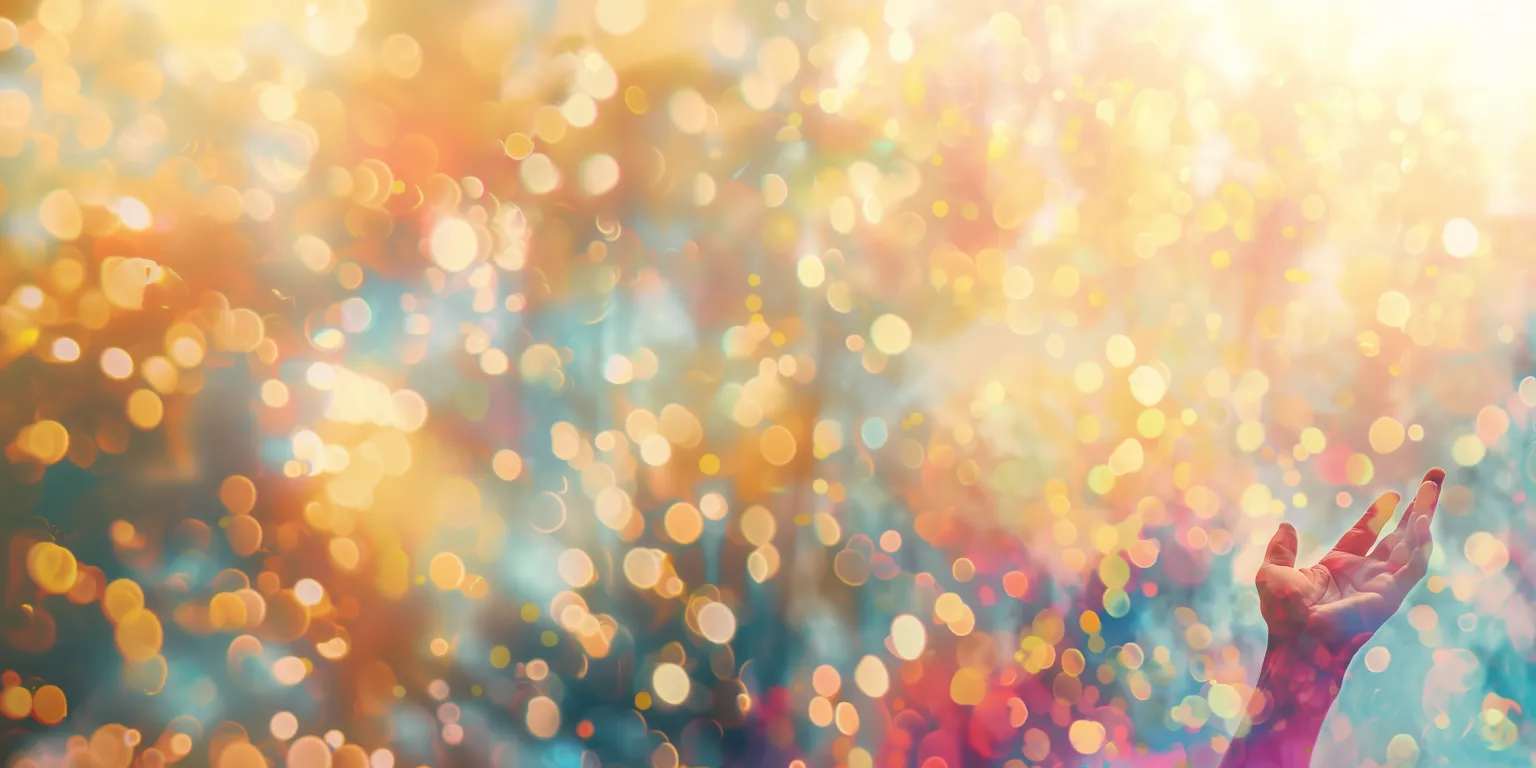






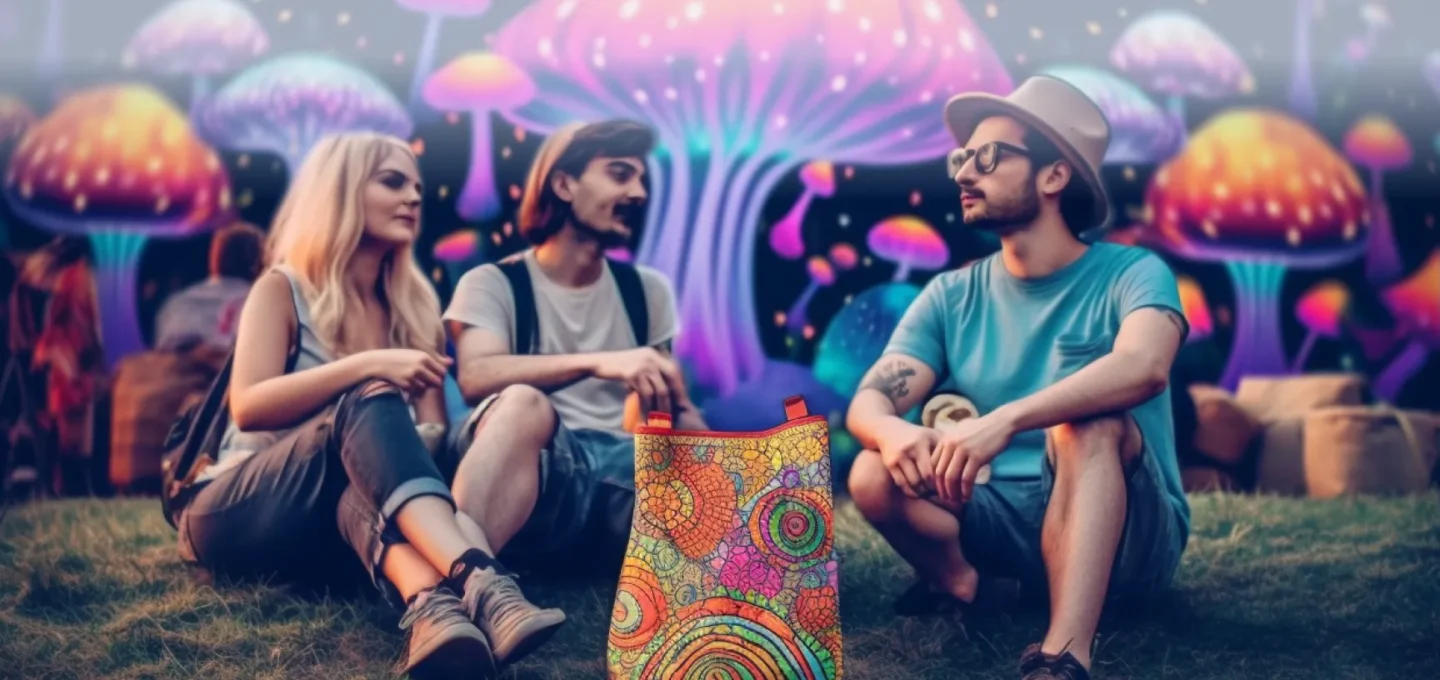
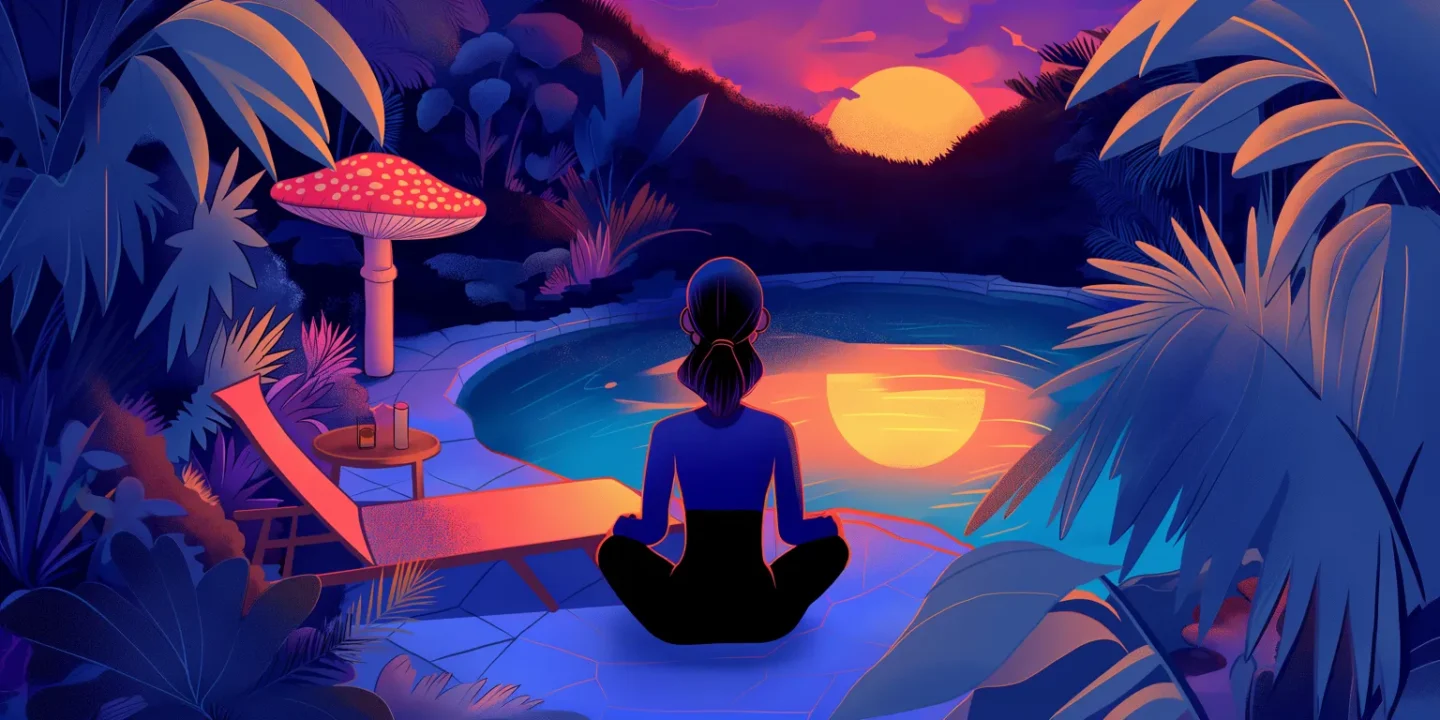




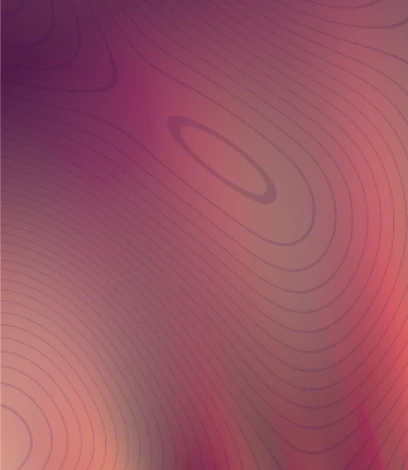

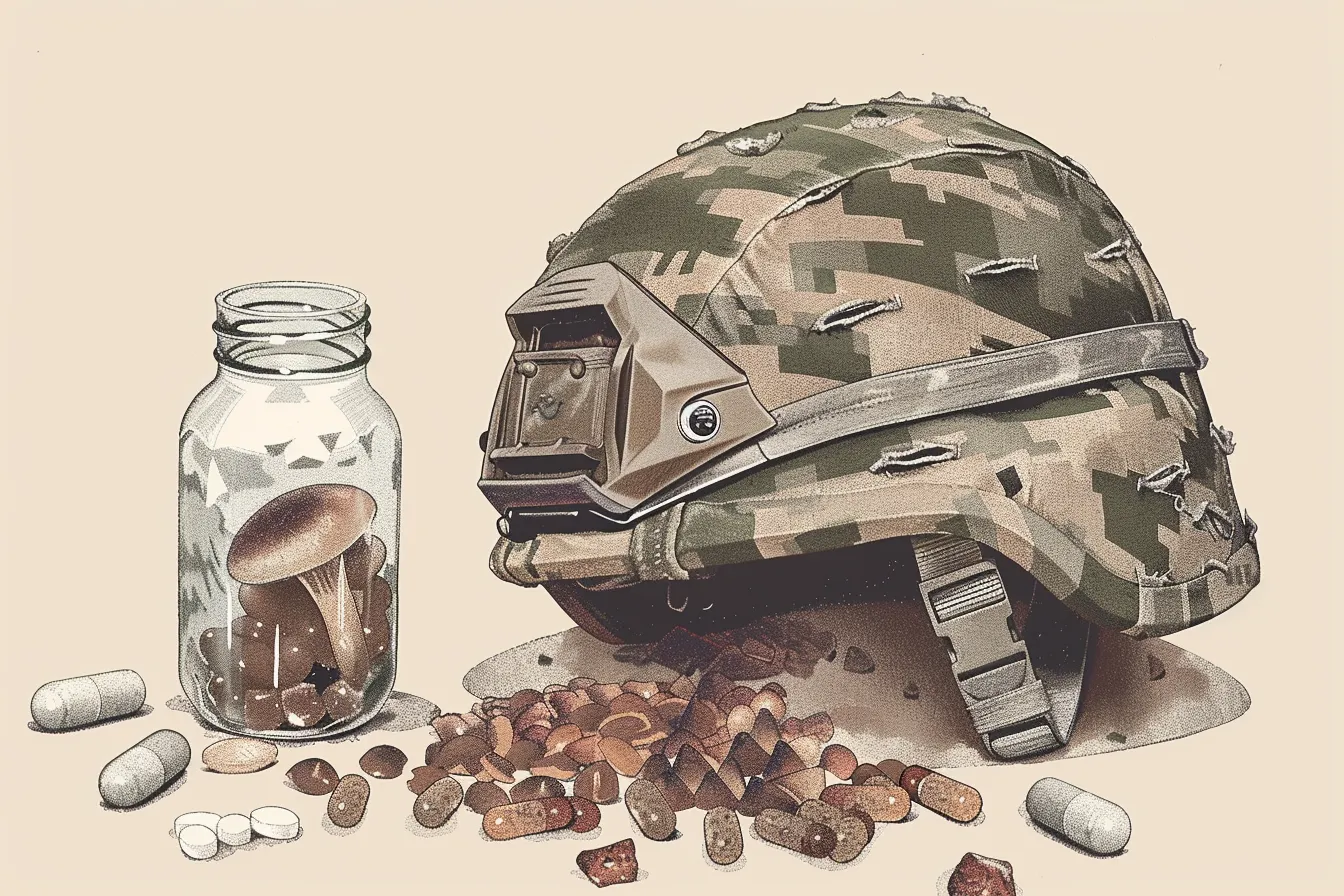

 Ben “Doc” Askins
Ben “Doc” Askins Edmund Murphy
Edmund Murphy David Connell
David Connell

 Lauren Smith
Lauren Smith


 Nick Hilden
Nick Hilden Sam Woolfe
Sam Woolfe